Physiological and Psychological Impact of Occupational Violence on Mental Health Nurses and Role of Nurse Manager: A Systematic Review
VerifiedAdded on 2022/10/10
|19
|5052
|467
AI Summary
This systematic review aims to elucidate the physiological and psychological impact of occupational violence on mental health nurses and the role of nurse manager in reducing its occurrence. The review includes articles published within the last 10 years and analyzes the factors associated with occupational violence and its aftermath.
Contribute Materials
Your contribution can guide someone’s learning journey. Share your
documents today.
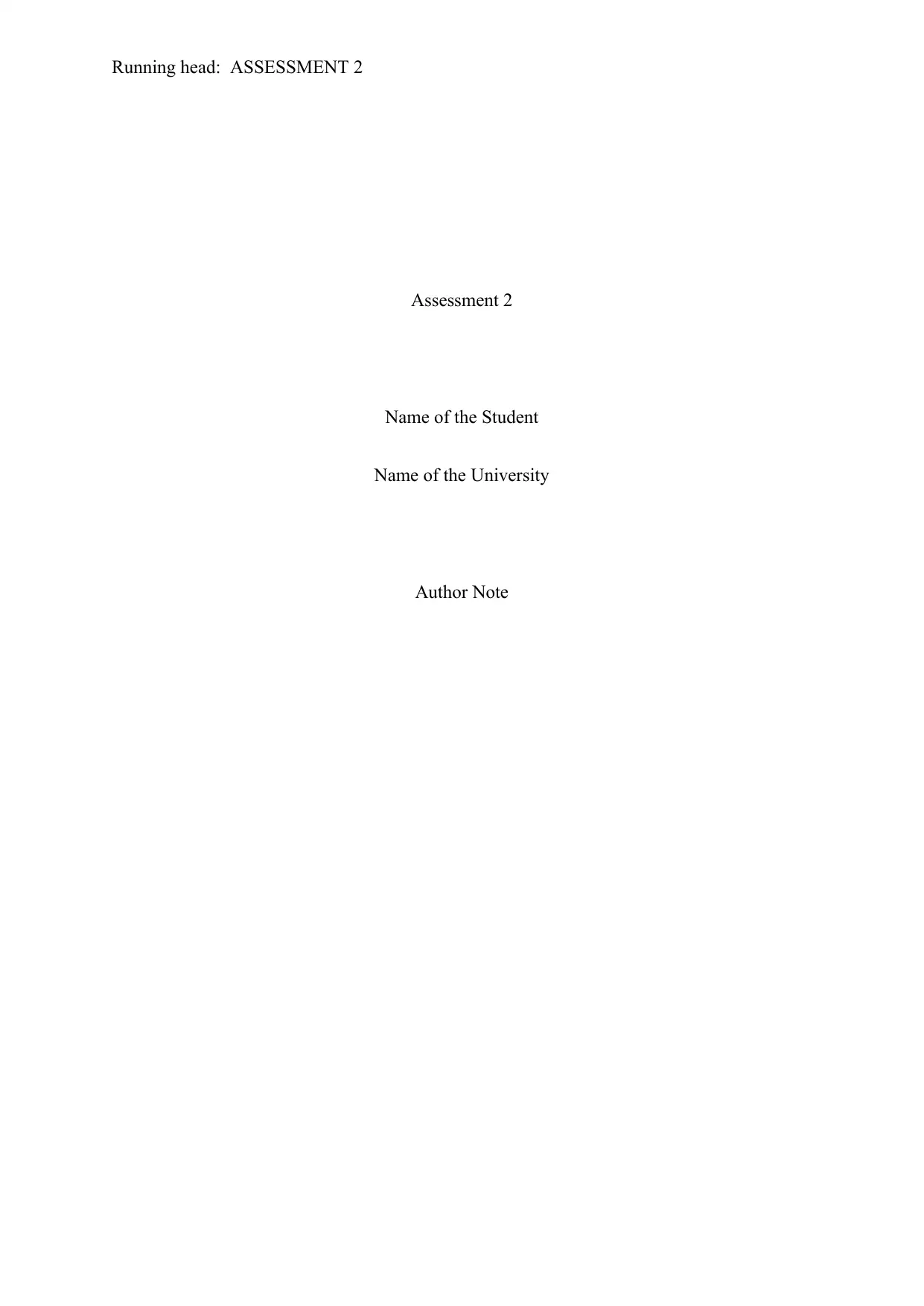
Running head: ASSESSMENT 2
Assessment 2
Name of the Student
Name of the University
Author Note
Assessment 2
Name of the Student
Name of the University
Author Note
Secure Best Marks with AI Grader
Need help grading? Try our AI Grader for instant feedback on your assignments.
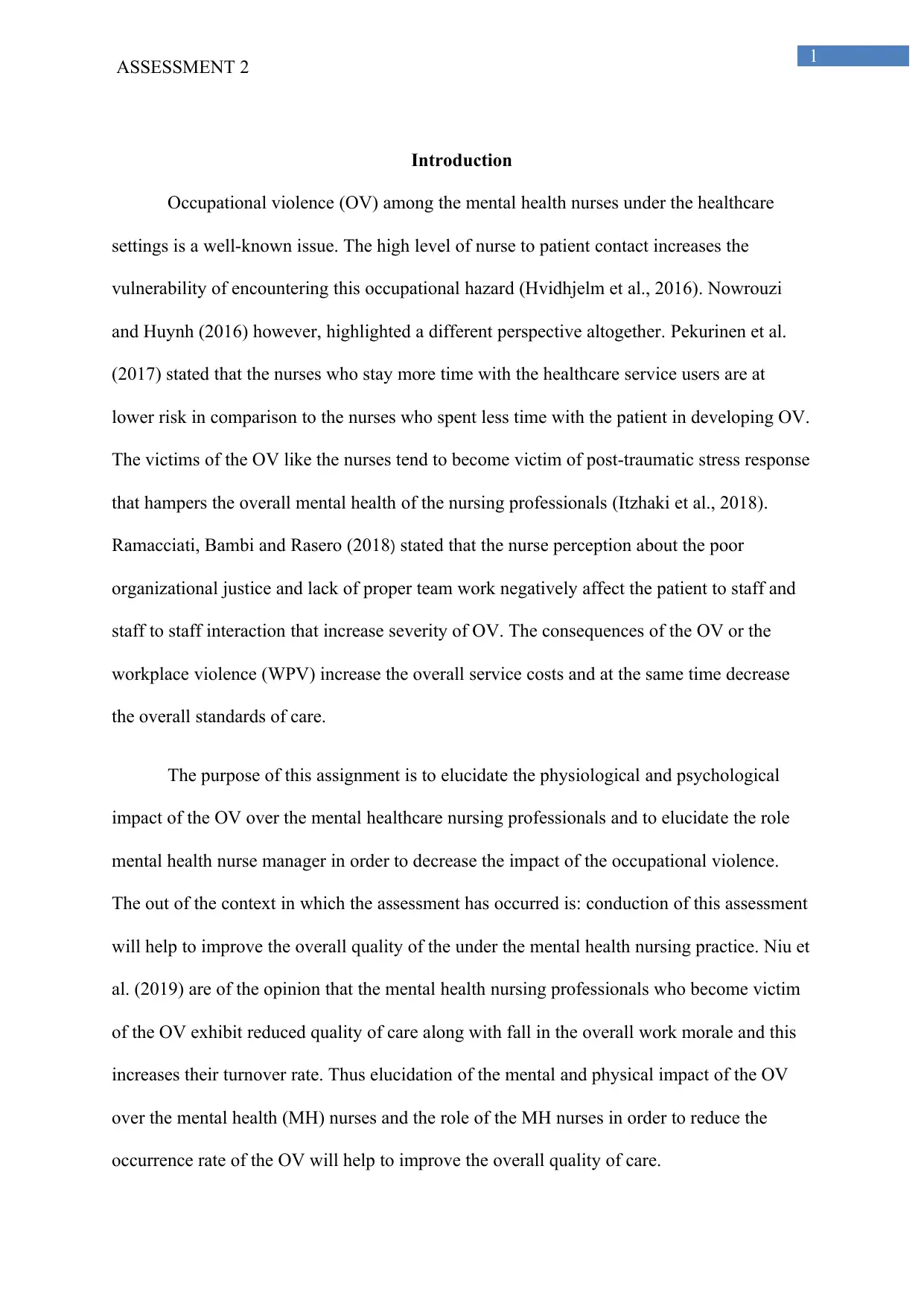
1
ASSESSMENT 2
Introduction
Occupational violence (OV) among the mental health nurses under the healthcare
settings is a well-known issue. The high level of nurse to patient contact increases the
vulnerability of encountering this occupational hazard (Hvidhjelm et al., 2016). Nowrouzi
and Huynh (2016) however, highlighted a different perspective altogether. Pekurinen et al.
(2017) stated that the nurses who stay more time with the healthcare service users are at
lower risk in comparison to the nurses who spent less time with the patient in developing OV.
The victims of the OV like the nurses tend to become victim of post-traumatic stress response
that hampers the overall mental health of the nursing professionals (Itzhaki et al., 2018).
Ramacciati, Bambi and Rasero (2018) stated that the nurse perception about the poor
organizational justice and lack of proper team work negatively affect the patient to staff and
staff to staff interaction that increase severity of OV. The consequences of the OV or the
workplace violence (WPV) increase the overall service costs and at the same time decrease
the overall standards of care.
The purpose of this assignment is to elucidate the physiological and psychological
impact of the OV over the mental healthcare nursing professionals and to elucidate the role
mental health nurse manager in order to decrease the impact of the occupational violence.
The out of the context in which the assessment has occurred is: conduction of this assessment
will help to improve the overall quality of the under the mental health nursing practice. Niu et
al. (2019) are of the opinion that the mental health nursing professionals who become victim
of the OV exhibit reduced quality of care along with fall in the overall work morale and this
increases their turnover rate. Thus elucidation of the mental and physical impact of the OV
over the mental health (MH) nurses and the role of the MH nurses in order to reduce the
occurrence rate of the OV will help to improve the overall quality of care.
ASSESSMENT 2
Introduction
Occupational violence (OV) among the mental health nurses under the healthcare
settings is a well-known issue. The high level of nurse to patient contact increases the
vulnerability of encountering this occupational hazard (Hvidhjelm et al., 2016). Nowrouzi
and Huynh (2016) however, highlighted a different perspective altogether. Pekurinen et al.
(2017) stated that the nurses who stay more time with the healthcare service users are at
lower risk in comparison to the nurses who spent less time with the patient in developing OV.
The victims of the OV like the nurses tend to become victim of post-traumatic stress response
that hampers the overall mental health of the nursing professionals (Itzhaki et al., 2018).
Ramacciati, Bambi and Rasero (2018) stated that the nurse perception about the poor
organizational justice and lack of proper team work negatively affect the patient to staff and
staff to staff interaction that increase severity of OV. The consequences of the OV or the
workplace violence (WPV) increase the overall service costs and at the same time decrease
the overall standards of care.
The purpose of this assignment is to elucidate the physiological and psychological
impact of the OV over the mental healthcare nursing professionals and to elucidate the role
mental health nurse manager in order to decrease the impact of the occupational violence.
The out of the context in which the assessment has occurred is: conduction of this assessment
will help to improve the overall quality of the under the mental health nursing practice. Niu et
al. (2019) are of the opinion that the mental health nursing professionals who become victim
of the OV exhibit reduced quality of care along with fall in the overall work morale and this
increases their turnover rate. Thus elucidation of the mental and physical impact of the OV
over the mental health (MH) nurses and the role of the MH nurses in order to reduce the
occurrence rate of the OV will help to improve the overall quality of care.
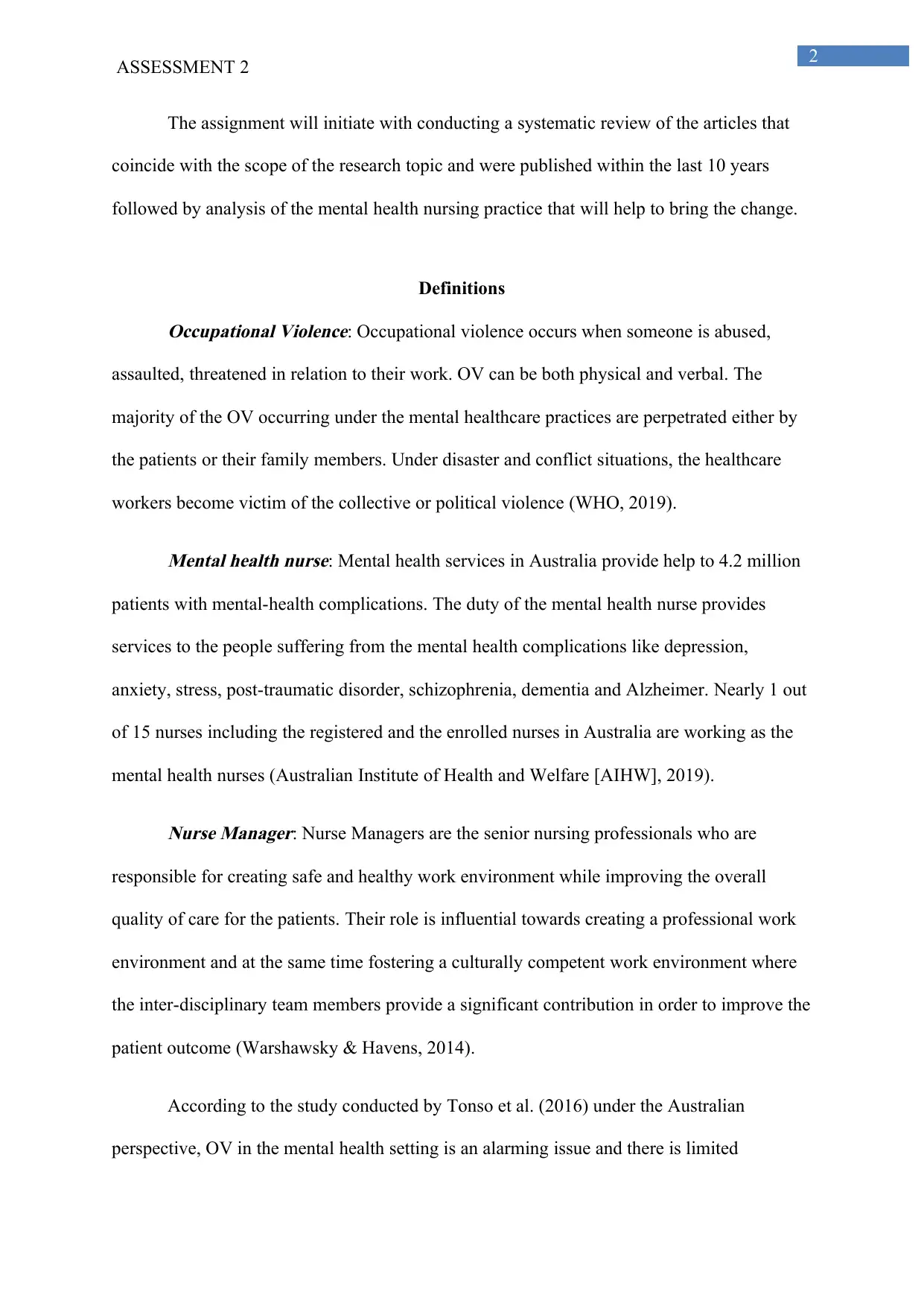
2
ASSESSMENT 2
The assignment will initiate with conducting a systematic review of the articles that
coincide with the scope of the research topic and were published within the last 10 years
followed by analysis of the mental health nursing practice that will help to bring the change.
DefinitionsOccupational Violence: Occupational violence occurs when someone is abused,
assaulted, threatened in relation to their work. OV can be both physical and verbal. The
majority of the OV occurring under the mental healthcare practices are perpetrated either by
the patients or their family members. Under disaster and conflict situations, the healthcare
workers become victim of the collective or political violence (WHO, 2019).
Mental health nurse: Mental health services in Australia provide help to 4.2 million
patients with mental-health complications. The duty of the mental health nurse provides
services to the people suffering from the mental health complications like depression,
anxiety, stress, post-traumatic disorder, schizophrenia, dementia and Alzheimer. Nearly 1 out
of 15 nurses including the registered and the enrolled nurses in Australia are working as the
mental health nurses (Australian Institute of Health and Welfare [AIHW], 2019).
Nurse Manager: Nurse Managers are the senior nursing professionals who are
responsible for creating safe and healthy work environment while improving the overall
quality of care for the patients. Their role is influential towards creating a professional work
environment and at the same time fostering a culturally competent work environment where
the inter-disciplinary team members provide a significant contribution in order to improve the
patient outcome (Warshawsky & Havens, 2014).
According to the study conducted by Tonso et al. (2016) under the Australian
perspective, OV in the mental health setting is an alarming issue and there is limited
ASSESSMENT 2
The assignment will initiate with conducting a systematic review of the articles that
coincide with the scope of the research topic and were published within the last 10 years
followed by analysis of the mental health nursing practice that will help to bring the change.
DefinitionsOccupational Violence: Occupational violence occurs when someone is abused,
assaulted, threatened in relation to their work. OV can be both physical and verbal. The
majority of the OV occurring under the mental healthcare practices are perpetrated either by
the patients or their family members. Under disaster and conflict situations, the healthcare
workers become victim of the collective or political violence (WHO, 2019).
Mental health nurse: Mental health services in Australia provide help to 4.2 million
patients with mental-health complications. The duty of the mental health nurse provides
services to the people suffering from the mental health complications like depression,
anxiety, stress, post-traumatic disorder, schizophrenia, dementia and Alzheimer. Nearly 1 out
of 15 nurses including the registered and the enrolled nurses in Australia are working as the
mental health nurses (Australian Institute of Health and Welfare [AIHW], 2019).
Nurse Manager: Nurse Managers are the senior nursing professionals who are
responsible for creating safe and healthy work environment while improving the overall
quality of care for the patients. Their role is influential towards creating a professional work
environment and at the same time fostering a culturally competent work environment where
the inter-disciplinary team members provide a significant contribution in order to improve the
patient outcome (Warshawsky & Havens, 2014).
According to the study conducted by Tonso et al. (2016) under the Australian
perspective, OV in the mental health setting is an alarming issue and there is limited
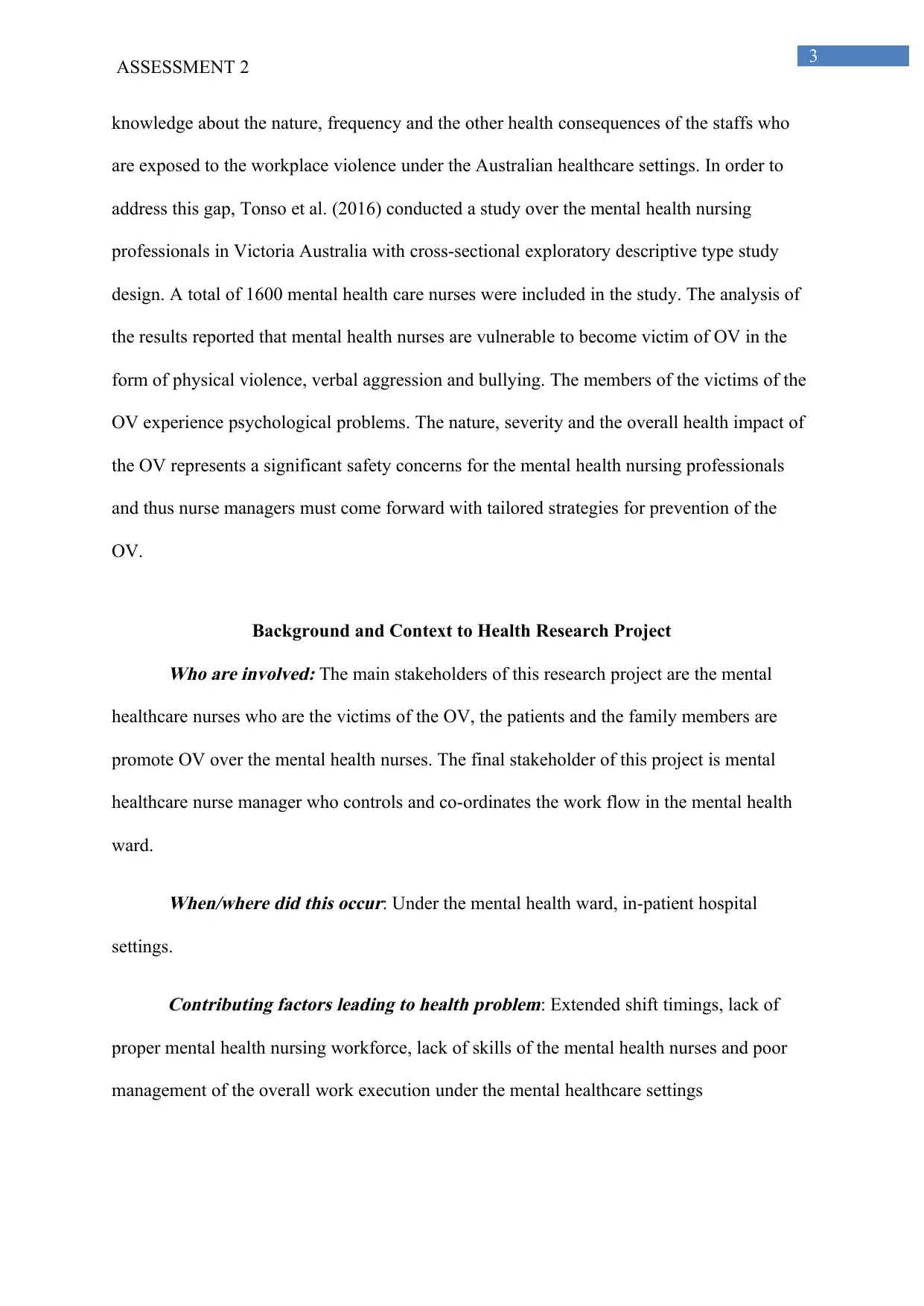
3
ASSESSMENT 2
knowledge about the nature, frequency and the other health consequences of the staffs who
are exposed to the workplace violence under the Australian healthcare settings. In order to
address this gap, Tonso et al. (2016) conducted a study over the mental health nursing
professionals in Victoria Australia with cross-sectional exploratory descriptive type study
design. A total of 1600 mental health care nurses were included in the study. The analysis of
the results reported that mental health nurses are vulnerable to become victim of OV in the
form of physical violence, verbal aggression and bullying. The members of the victims of the
OV experience psychological problems. The nature, severity and the overall health impact of
the OV represents a significant safety concerns for the mental health nursing professionals
and thus nurse managers must come forward with tailored strategies for prevention of the
OV.
Background and Context to Health Research ProjectWho are involved: The main stakeholders of this research project are the mental
healthcare nurses who are the victims of the OV, the patients and the family members are
promote OV over the mental health nurses. The final stakeholder of this project is mental
healthcare nurse manager who controls and co-ordinates the work flow in the mental health
ward. When/where did this occur: Under the mental health ward, in-patient hospital
settings.
Contributing factors leading to health problem: Extended shift timings, lack of
proper mental health nursing workforce, lack of skills of the mental health nurses and poor
management of the overall work execution under the mental healthcare settings
ASSESSMENT 2
knowledge about the nature, frequency and the other health consequences of the staffs who
are exposed to the workplace violence under the Australian healthcare settings. In order to
address this gap, Tonso et al. (2016) conducted a study over the mental health nursing
professionals in Victoria Australia with cross-sectional exploratory descriptive type study
design. A total of 1600 mental health care nurses were included in the study. The analysis of
the results reported that mental health nurses are vulnerable to become victim of OV in the
form of physical violence, verbal aggression and bullying. The members of the victims of the
OV experience psychological problems. The nature, severity and the overall health impact of
the OV represents a significant safety concerns for the mental health nursing professionals
and thus nurse managers must come forward with tailored strategies for prevention of the
OV.
Background and Context to Health Research ProjectWho are involved: The main stakeholders of this research project are the mental
healthcare nurses who are the victims of the OV, the patients and the family members are
promote OV over the mental health nurses. The final stakeholder of this project is mental
healthcare nurse manager who controls and co-ordinates the work flow in the mental health
ward. When/where did this occur: Under the mental health ward, in-patient hospital
settings.
Contributing factors leading to health problem: Extended shift timings, lack of
proper mental health nursing workforce, lack of skills of the mental health nurses and poor
management of the overall work execution under the mental healthcare settings
Secure Best Marks with AI Grader
Need help grading? Try our AI Grader for instant feedback on your assignments.
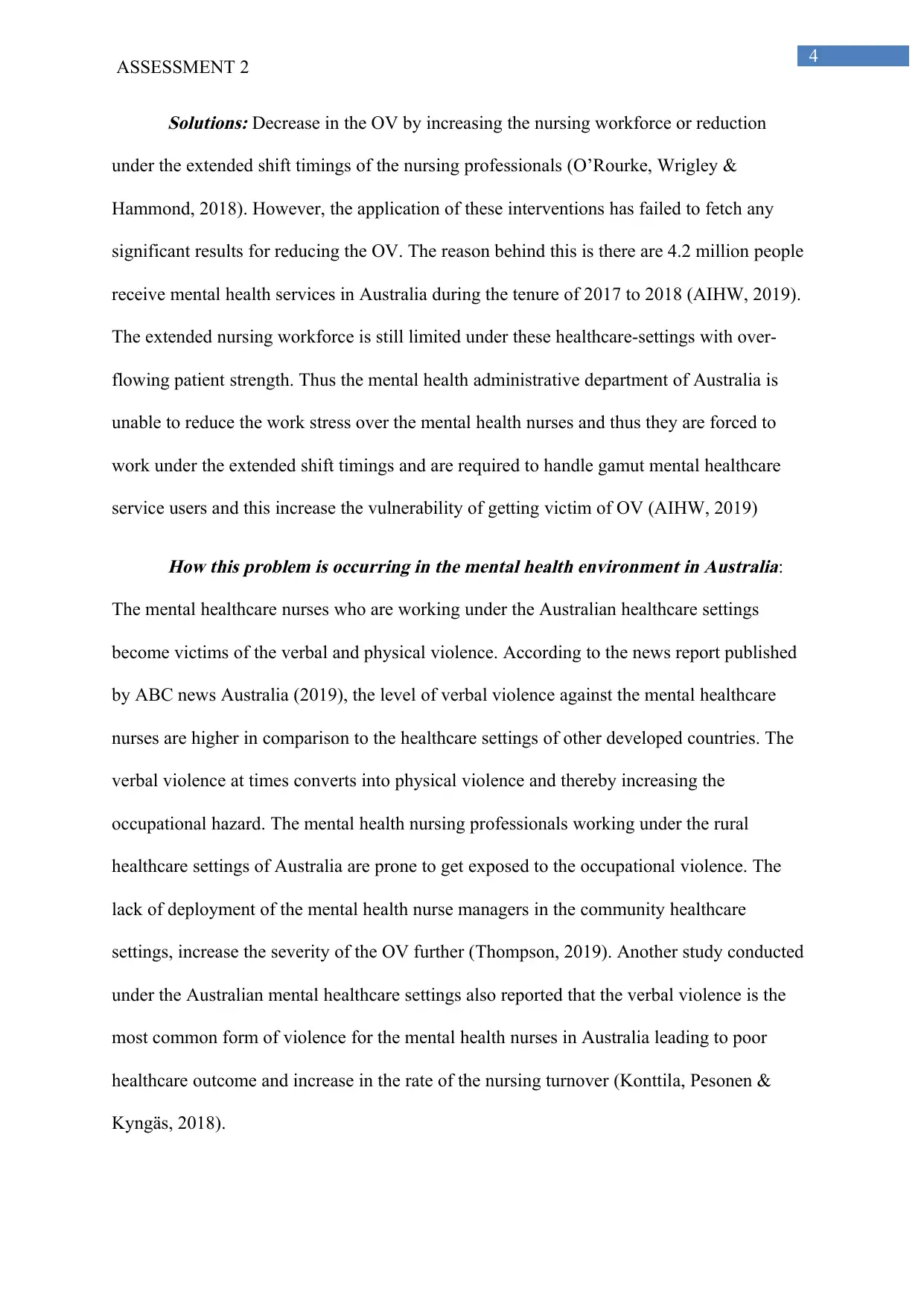
4
ASSESSMENT 2
Solutions: Decrease in the OV by increasing the nursing workforce or reduction
under the extended shift timings of the nursing professionals (O’Rourke, Wrigley &
Hammond, 2018). However, the application of these interventions has failed to fetch any
significant results for reducing the OV. The reason behind this is there are 4.2 million people
receive mental health services in Australia during the tenure of 2017 to 2018 (AIHW, 2019).
The extended nursing workforce is still limited under these healthcare-settings with over-
flowing patient strength. Thus the mental health administrative department of Australia is
unable to reduce the work stress over the mental health nurses and thus they are forced to
work under the extended shift timings and are required to handle gamut mental healthcare
service users and this increase the vulnerability of getting victim of OV (AIHW, 2019)
How this problem is occurring in the mental health environment in Australia:
The mental healthcare nurses who are working under the Australian healthcare settings
become victims of the verbal and physical violence. According to the news report published
by ABC news Australia (2019), the level of verbal violence against the mental healthcare
nurses are higher in comparison to the healthcare settings of other developed countries. The
verbal violence at times converts into physical violence and thereby increasing the
occupational hazard. The mental health nursing professionals working under the rural
healthcare settings of Australia are prone to get exposed to the occupational violence. The
lack of deployment of the mental health nurse managers in the community healthcare
settings, increase the severity of the OV further (Thompson, 2019). Another study conducted
under the Australian mental healthcare settings also reported that the verbal violence is the
most common form of violence for the mental health nurses in Australia leading to poor
healthcare outcome and increase in the rate of the nursing turnover (Konttila, Pesonen &
Kyngäs, 2018).
ASSESSMENT 2
Solutions: Decrease in the OV by increasing the nursing workforce or reduction
under the extended shift timings of the nursing professionals (O’Rourke, Wrigley &
Hammond, 2018). However, the application of these interventions has failed to fetch any
significant results for reducing the OV. The reason behind this is there are 4.2 million people
receive mental health services in Australia during the tenure of 2017 to 2018 (AIHW, 2019).
The extended nursing workforce is still limited under these healthcare-settings with over-
flowing patient strength. Thus the mental health administrative department of Australia is
unable to reduce the work stress over the mental health nurses and thus they are forced to
work under the extended shift timings and are required to handle gamut mental healthcare
service users and this increase the vulnerability of getting victim of OV (AIHW, 2019)
How this problem is occurring in the mental health environment in Australia:
The mental healthcare nurses who are working under the Australian healthcare settings
become victims of the verbal and physical violence. According to the news report published
by ABC news Australia (2019), the level of verbal violence against the mental healthcare
nurses are higher in comparison to the healthcare settings of other developed countries. The
verbal violence at times converts into physical violence and thereby increasing the
occupational hazard. The mental health nursing professionals working under the rural
healthcare settings of Australia are prone to get exposed to the occupational violence. The
lack of deployment of the mental health nurse managers in the community healthcare
settings, increase the severity of the OV further (Thompson, 2019). Another study conducted
under the Australian mental healthcare settings also reported that the verbal violence is the
most common form of violence for the mental health nurses in Australia leading to poor
healthcare outcome and increase in the rate of the nursing turnover (Konttila, Pesonen &
Kyngäs, 2018).
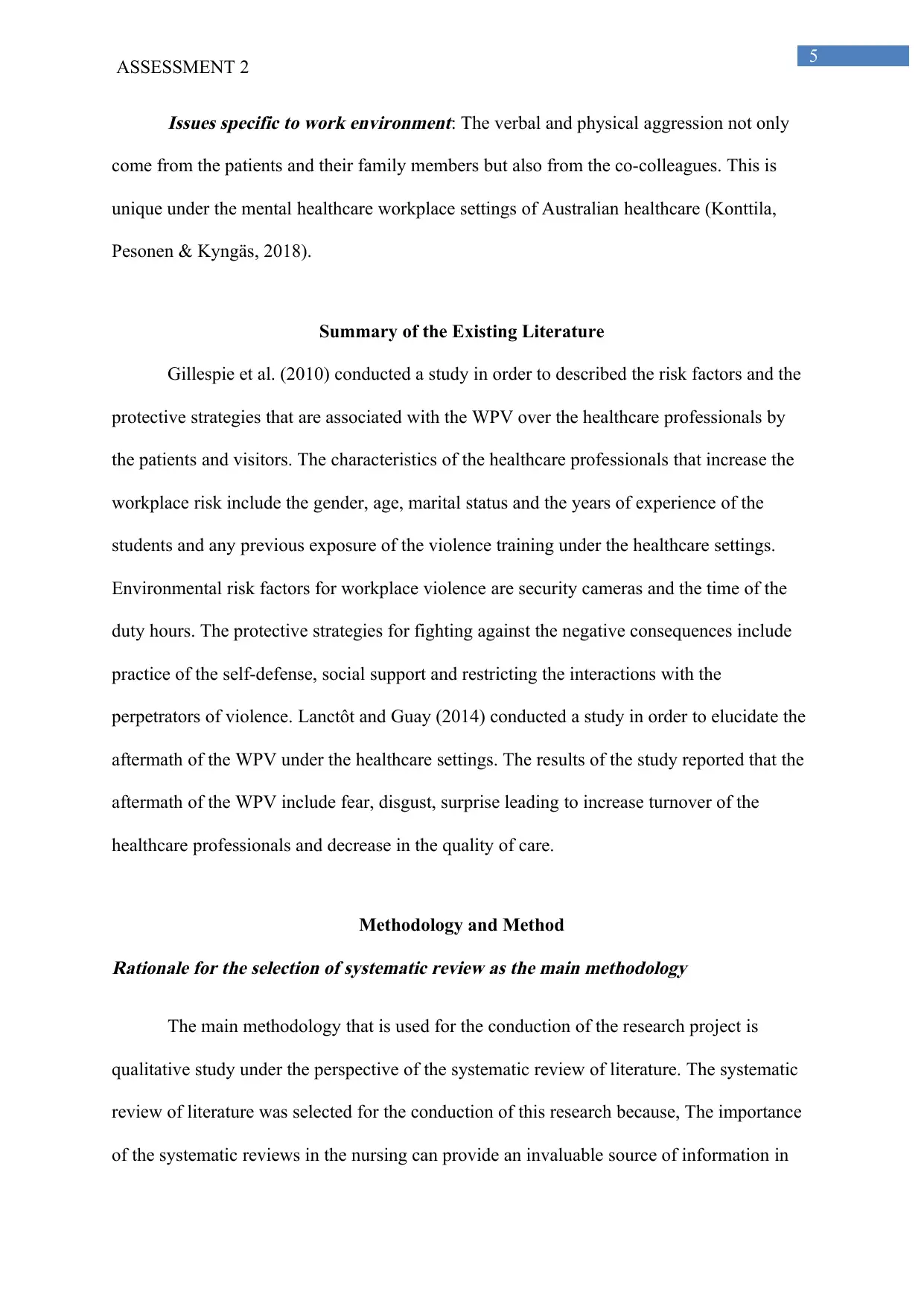
5
ASSESSMENT 2
Issues specific to work environment: The verbal and physical aggression not only
come from the patients and their family members but also from the co-colleagues. This is
unique under the mental healthcare workplace settings of Australian healthcare (Konttila,
Pesonen & Kyngäs, 2018).
Summary of the Existing Literature
Gillespie et al. (2010) conducted a study in order to described the risk factors and the
protective strategies that are associated with the WPV over the healthcare professionals by
the patients and visitors. The characteristics of the healthcare professionals that increase the
workplace risk include the gender, age, marital status and the years of experience of the
students and any previous exposure of the violence training under the healthcare settings.
Environmental risk factors for workplace violence are security cameras and the time of the
duty hours. The protective strategies for fighting against the negative consequences include
practice of the self-defense, social support and restricting the interactions with the
perpetrators of violence. Lanctôt and Guay (2014) conducted a study in order to elucidate the
aftermath of the WPV under the healthcare settings. The results of the study reported that the
aftermath of the WPV include fear, disgust, surprise leading to increase turnover of the
healthcare professionals and decrease in the quality of care.
Methodology and Method
Rationale for the selection of systematic review as the main methodology
The main methodology that is used for the conduction of the research project is
qualitative study under the perspective of the systematic review of literature. The systematic
review of literature was selected for the conduction of this research because, The importance
of the systematic reviews in the nursing can provide an invaluable source of information in
ASSESSMENT 2
Issues specific to work environment: The verbal and physical aggression not only
come from the patients and their family members but also from the co-colleagues. This is
unique under the mental healthcare workplace settings of Australian healthcare (Konttila,
Pesonen & Kyngäs, 2018).
Summary of the Existing Literature
Gillespie et al. (2010) conducted a study in order to described the risk factors and the
protective strategies that are associated with the WPV over the healthcare professionals by
the patients and visitors. The characteristics of the healthcare professionals that increase the
workplace risk include the gender, age, marital status and the years of experience of the
students and any previous exposure of the violence training under the healthcare settings.
Environmental risk factors for workplace violence are security cameras and the time of the
duty hours. The protective strategies for fighting against the negative consequences include
practice of the self-defense, social support and restricting the interactions with the
perpetrators of violence. Lanctôt and Guay (2014) conducted a study in order to elucidate the
aftermath of the WPV under the healthcare settings. The results of the study reported that the
aftermath of the WPV include fear, disgust, surprise leading to increase turnover of the
healthcare professionals and decrease in the quality of care.
Methodology and Method
Rationale for the selection of systematic review as the main methodology
The main methodology that is used for the conduction of the research project is
qualitative study under the perspective of the systematic review of literature. The systematic
review of literature was selected for the conduction of this research because, The importance
of the systematic reviews in the nursing can provide an invaluable source of information in
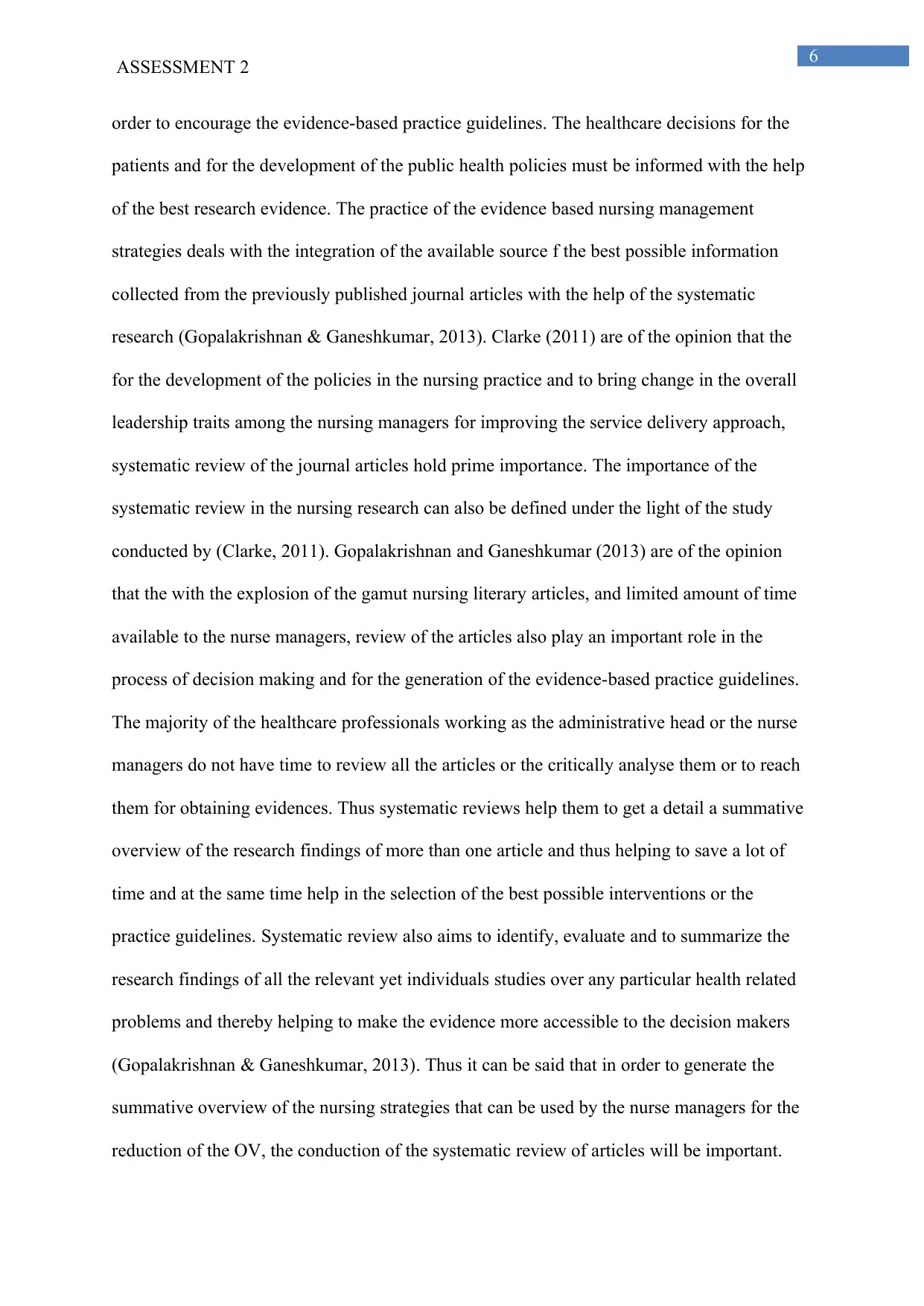
6
ASSESSMENT 2
order to encourage the evidence-based practice guidelines. The healthcare decisions for the
patients and for the development of the public health policies must be informed with the help
of the best research evidence. The practice of the evidence based nursing management
strategies deals with the integration of the available source f the best possible information
collected from the previously published journal articles with the help of the systematic
research (Gopalakrishnan & Ganeshkumar, 2013). Clarke (2011) are of the opinion that the
for the development of the policies in the nursing practice and to bring change in the overall
leadership traits among the nursing managers for improving the service delivery approach,
systematic review of the journal articles hold prime importance. The importance of the
systematic review in the nursing research can also be defined under the light of the study
conducted by (Clarke, 2011). Gopalakrishnan and Ganeshkumar (2013) are of the opinion
that the with the explosion of the gamut nursing literary articles, and limited amount of time
available to the nurse managers, review of the articles also play an important role in the
process of decision making and for the generation of the evidence-based practice guidelines.
The majority of the healthcare professionals working as the administrative head or the nurse
managers do not have time to review all the articles or the critically analyse them or to reach
them for obtaining evidences. Thus systematic reviews help them to get a detail a summative
overview of the research findings of more than one article and thus helping to save a lot of
time and at the same time help in the selection of the best possible interventions or the
practice guidelines. Systematic review also aims to identify, evaluate and to summarize the
research findings of all the relevant yet individuals studies over any particular health related
problems and thereby helping to make the evidence more accessible to the decision makers
(Gopalakrishnan & Ganeshkumar, 2013). Thus it can be said that in order to generate the
summative overview of the nursing strategies that can be used by the nurse managers for the
reduction of the OV, the conduction of the systematic review of articles will be important.
ASSESSMENT 2
order to encourage the evidence-based practice guidelines. The healthcare decisions for the
patients and for the development of the public health policies must be informed with the help
of the best research evidence. The practice of the evidence based nursing management
strategies deals with the integration of the available source f the best possible information
collected from the previously published journal articles with the help of the systematic
research (Gopalakrishnan & Ganeshkumar, 2013). Clarke (2011) are of the opinion that the
for the development of the policies in the nursing practice and to bring change in the overall
leadership traits among the nursing managers for improving the service delivery approach,
systematic review of the journal articles hold prime importance. The importance of the
systematic review in the nursing research can also be defined under the light of the study
conducted by (Clarke, 2011). Gopalakrishnan and Ganeshkumar (2013) are of the opinion
that the with the explosion of the gamut nursing literary articles, and limited amount of time
available to the nurse managers, review of the articles also play an important role in the
process of decision making and for the generation of the evidence-based practice guidelines.
The majority of the healthcare professionals working as the administrative head or the nurse
managers do not have time to review all the articles or the critically analyse them or to reach
them for obtaining evidences. Thus systematic reviews help them to get a detail a summative
overview of the research findings of more than one article and thus helping to save a lot of
time and at the same time help in the selection of the best possible interventions or the
practice guidelines. Systematic review also aims to identify, evaluate and to summarize the
research findings of all the relevant yet individuals studies over any particular health related
problems and thereby helping to make the evidence more accessible to the decision makers
(Gopalakrishnan & Ganeshkumar, 2013). Thus it can be said that in order to generate the
summative overview of the nursing strategies that can be used by the nurse managers for the
reduction of the OV, the conduction of the systematic review of articles will be important.
Paraphrase This Document
Need a fresh take? Get an instant paraphrase of this document with our AI Paraphraser
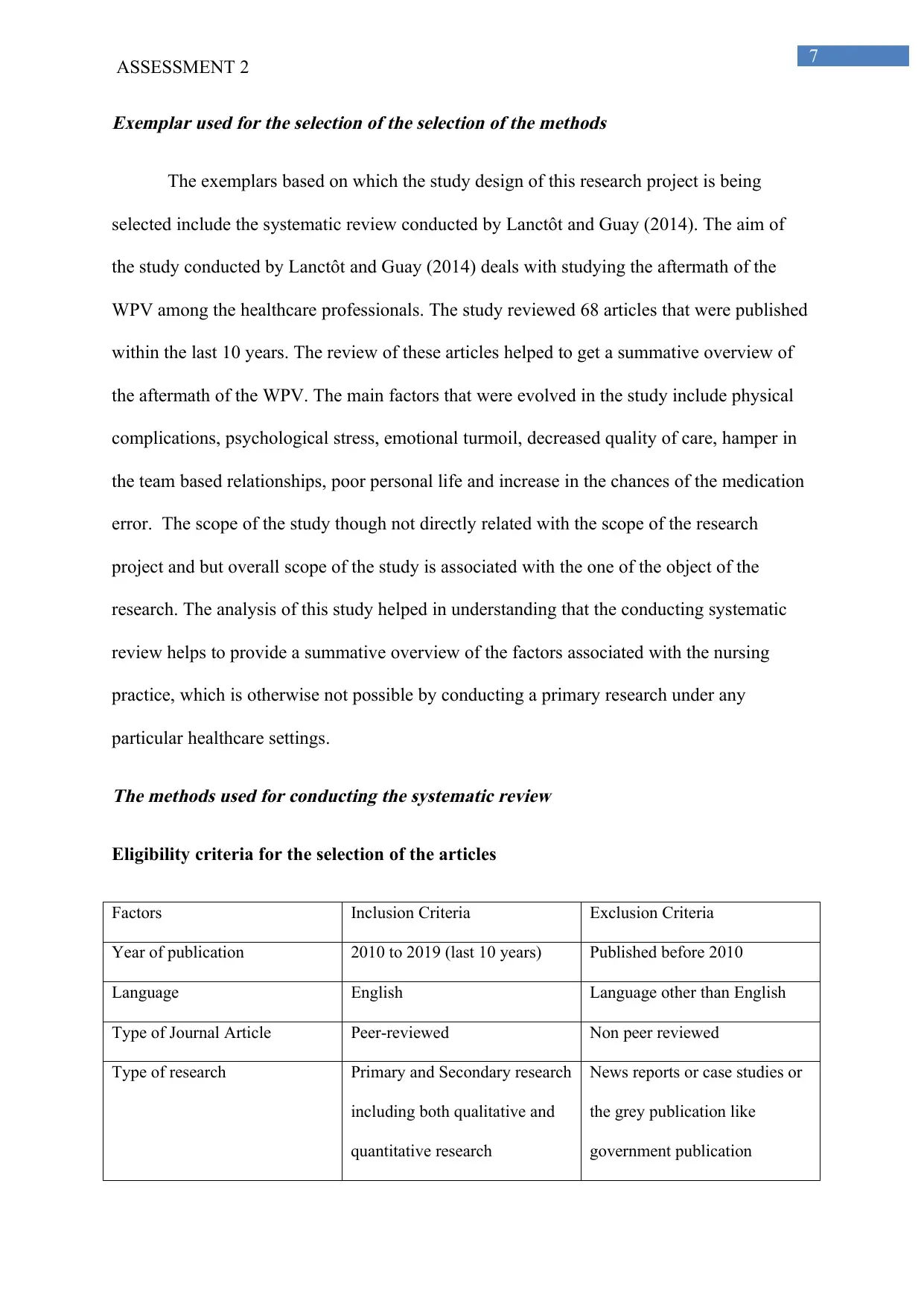
7
ASSESSMENT 2
Exemplar used for the selection of the selection of the methods
The exemplars based on which the study design of this research project is being
selected include the systematic review conducted by Lanctôt and Guay (2014). The aim of
the study conducted by Lanctôt and Guay (2014) deals with studying the aftermath of the
WPV among the healthcare professionals. The study reviewed 68 articles that were published
within the last 10 years. The review of these articles helped to get a summative overview of
the aftermath of the WPV. The main factors that were evolved in the study include physical
complications, psychological stress, emotional turmoil, decreased quality of care, hamper in
the team based relationships, poor personal life and increase in the chances of the medication
error. The scope of the study though not directly related with the scope of the research
project and but overall scope of the study is associated with the one of the object of the
research. The analysis of this study helped in understanding that the conducting systematic
review helps to provide a summative overview of the factors associated with the nursing
practice, which is otherwise not possible by conducting a primary research under any
particular healthcare settings.
The methods used for conducting the systematic review
Eligibility criteria for the selection of the articles
Factors Inclusion Criteria Exclusion Criteria
Year of publication 2010 to 2019 (last 10 years) Published before 2010
Language English Language other than English
Type of Journal Article Peer-reviewed Non peer reviewed
Type of research Primary and Secondary research
including both qualitative and
quantitative research
News reports or case studies or
the grey publication like
government publication
ASSESSMENT 2
Exemplar used for the selection of the selection of the methods
The exemplars based on which the study design of this research project is being
selected include the systematic review conducted by Lanctôt and Guay (2014). The aim of
the study conducted by Lanctôt and Guay (2014) deals with studying the aftermath of the
WPV among the healthcare professionals. The study reviewed 68 articles that were published
within the last 10 years. The review of these articles helped to get a summative overview of
the aftermath of the WPV. The main factors that were evolved in the study include physical
complications, psychological stress, emotional turmoil, decreased quality of care, hamper in
the team based relationships, poor personal life and increase in the chances of the medication
error. The scope of the study though not directly related with the scope of the research
project and but overall scope of the study is associated with the one of the object of the
research. The analysis of this study helped in understanding that the conducting systematic
review helps to provide a summative overview of the factors associated with the nursing
practice, which is otherwise not possible by conducting a primary research under any
particular healthcare settings.
The methods used for conducting the systematic review
Eligibility criteria for the selection of the articles
Factors Inclusion Criteria Exclusion Criteria
Year of publication 2010 to 2019 (last 10 years) Published before 2010
Language English Language other than English
Type of Journal Article Peer-reviewed Non peer reviewed
Type of research Primary and Secondary research
including both qualitative and
quantitative research
News reports or case studies or
the grey publication like
government publication
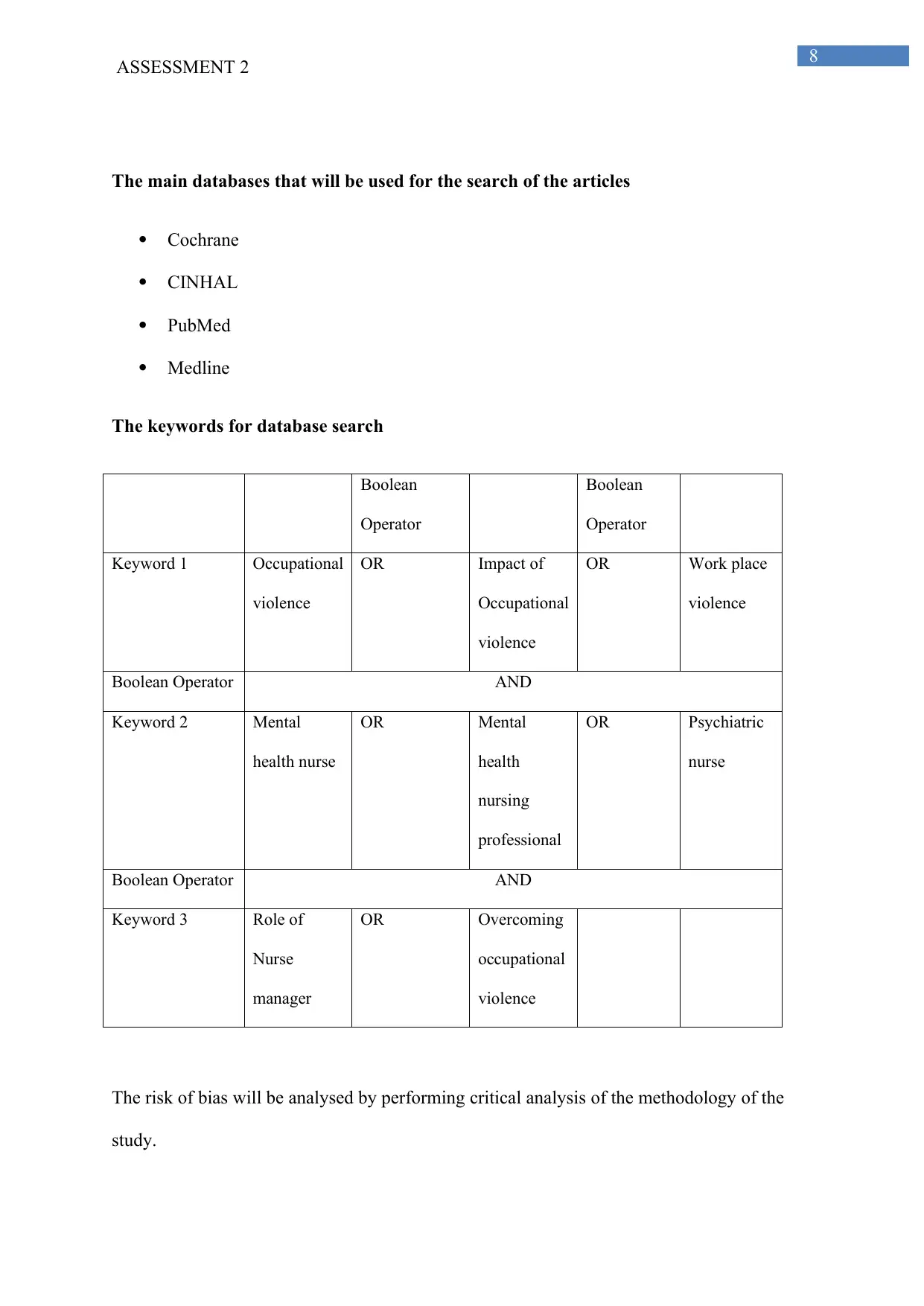
8
ASSESSMENT 2
The main databases that will be used for the search of the articles
Cochrane
CINHAL
PubMed
Medline
The keywords for database search
Boolean
Operator
Boolean
Operator
Keyword 1 Occupational
violence
OR Impact of
Occupational
violence
OR Work place
violence
Boolean Operator AND
Keyword 2 Mental
health nurse
OR Mental
health
nursing
professional
OR Psychiatric
nurse
Boolean Operator AND
Keyword 3 Role of
Nurse
manager
OR Overcoming
occupational
violence
The risk of bias will be analysed by performing critical analysis of the methodology of the
study.
ASSESSMENT 2
The main databases that will be used for the search of the articles
Cochrane
CINHAL
PubMed
Medline
The keywords for database search
Boolean
Operator
Boolean
Operator
Keyword 1 Occupational
violence
OR Impact of
Occupational
violence
OR Work place
violence
Boolean Operator AND
Keyword 2 Mental
health nurse
OR Mental
health
nursing
professional
OR Psychiatric
nurse
Boolean Operator AND
Keyword 3 Role of
Nurse
manager
OR Overcoming
occupational
violence
The risk of bias will be analysed by performing critical analysis of the methodology of the
study.

9
ASSESSMENT 2
ASSESSMENT 2
Secure Best Marks with AI Grader
Need help grading? Try our AI Grader for instant feedback on your assignments.
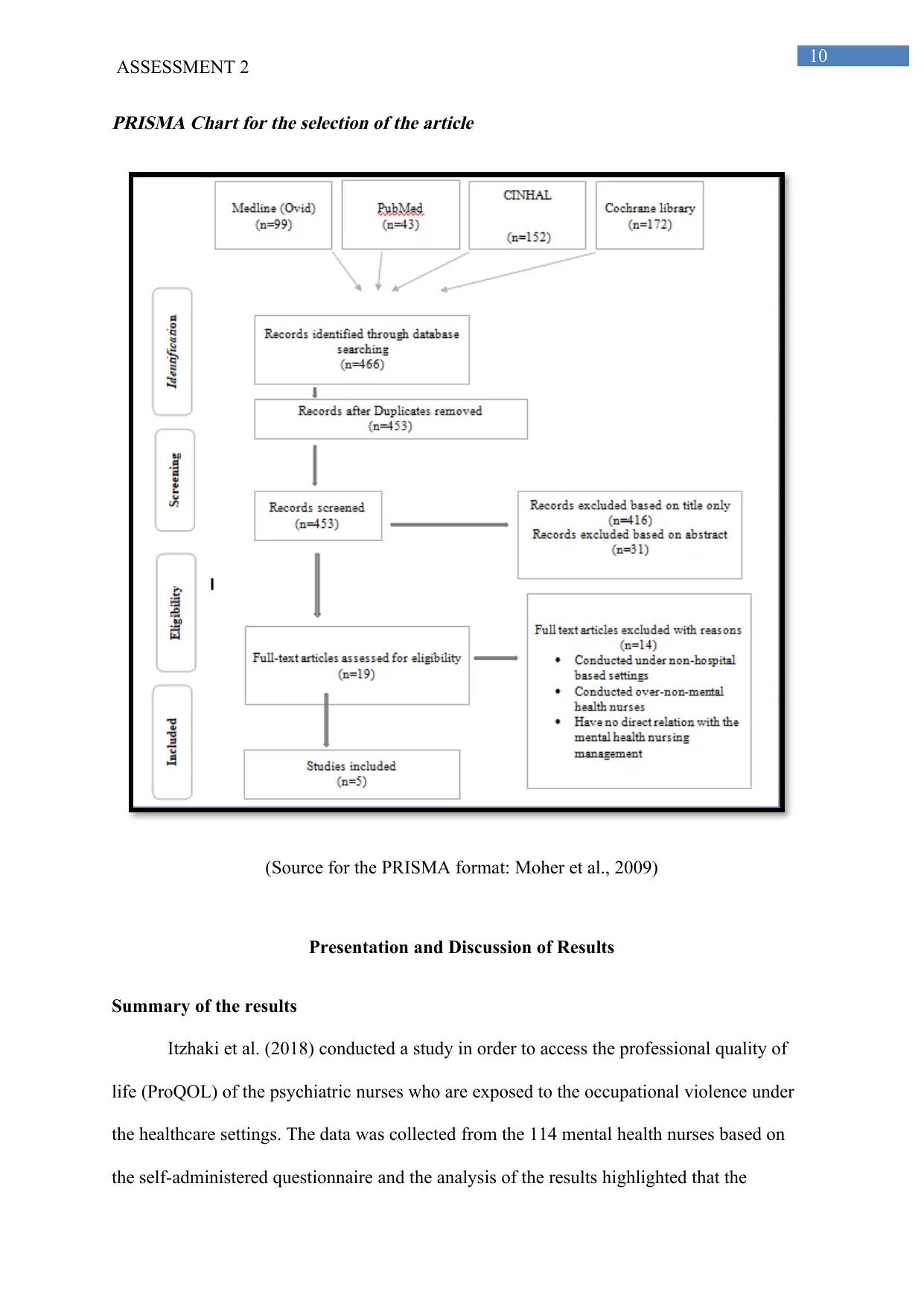
10
ASSESSMENT 2
PRISMA Chart for the selection of the article
(Source for the PRISMA format: Moher et al., 2009)
Presentation and Discussion of Results
Summary of the results
Itzhaki et al. (2018) conducted a study in order to access the professional quality of
life (ProQOL) of the psychiatric nurses who are exposed to the occupational violence under
the healthcare settings. The data was collected from the 114 mental health nurses based on
the self-administered questionnaire and the analysis of the results highlighted that the
ASSESSMENT 2
PRISMA Chart for the selection of the article
(Source for the PRISMA format: Moher et al., 2009)
Presentation and Discussion of Results
Summary of the results
Itzhaki et al. (2018) conducted a study in order to access the professional quality of
life (ProQOL) of the psychiatric nurses who are exposed to the occupational violence under
the healthcare settings. The data was collected from the 114 mental health nurses based on
the self-administered questionnaire and the analysis of the results highlighted that the
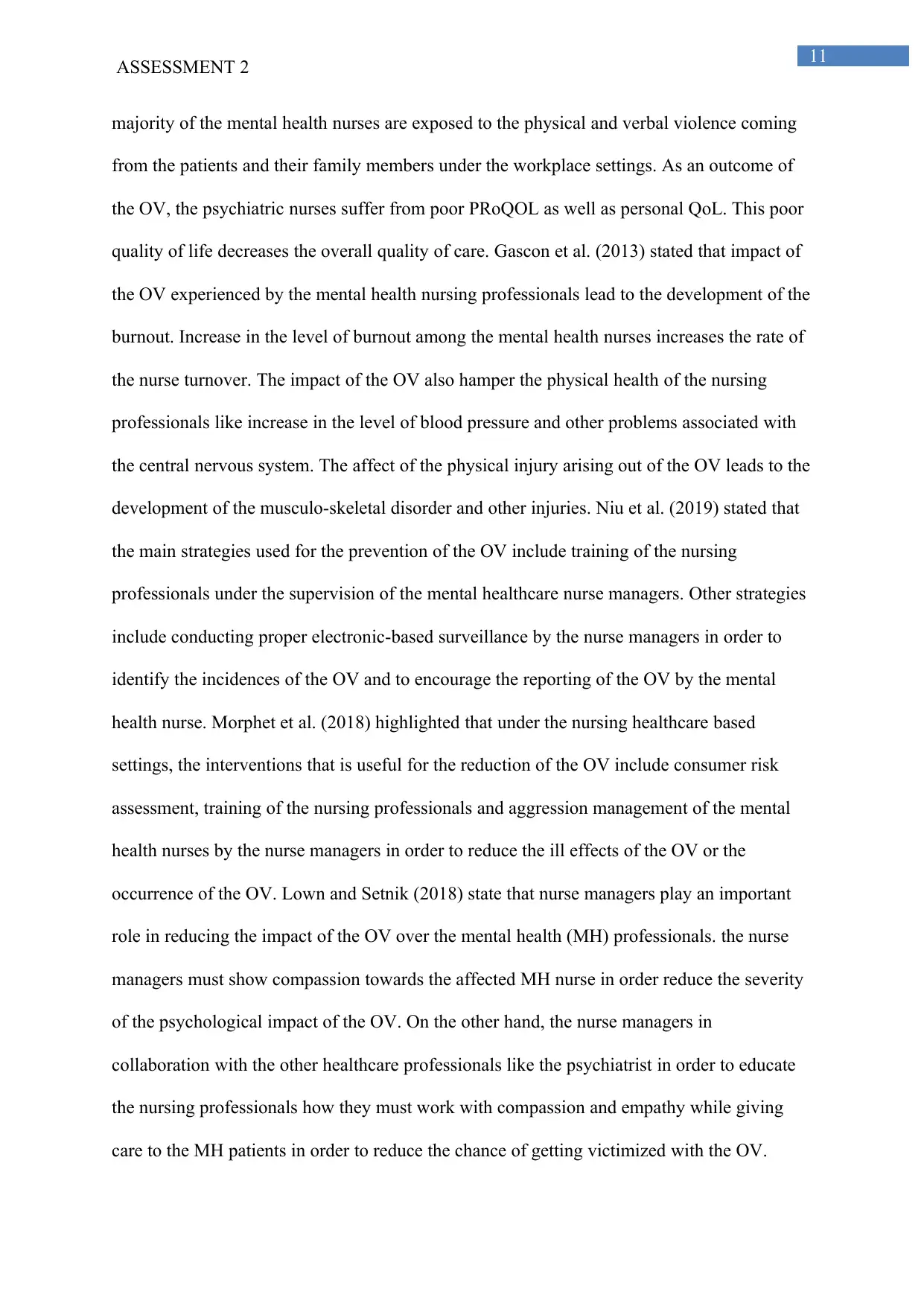
11
ASSESSMENT 2
majority of the mental health nurses are exposed to the physical and verbal violence coming
from the patients and their family members under the workplace settings. As an outcome of
the OV, the psychiatric nurses suffer from poor PRoQOL as well as personal QoL. This poor
quality of life decreases the overall quality of care. Gascon et al. (2013) stated that impact of
the OV experienced by the mental health nursing professionals lead to the development of the
burnout. Increase in the level of burnout among the mental health nurses increases the rate of
the nurse turnover. The impact of the OV also hamper the physical health of the nursing
professionals like increase in the level of blood pressure and other problems associated with
the central nervous system. The affect of the physical injury arising out of the OV leads to the
development of the musculo-skeletal disorder and other injuries. Niu et al. (2019) stated that
the main strategies used for the prevention of the OV include training of the nursing
professionals under the supervision of the mental healthcare nurse managers. Other strategies
include conducting proper electronic-based surveillance by the nurse managers in order to
identify the incidences of the OV and to encourage the reporting of the OV by the mental
health nurse. Morphet et al. (2018) highlighted that under the nursing healthcare based
settings, the interventions that is useful for the reduction of the OV include consumer risk
assessment, training of the nursing professionals and aggression management of the mental
health nurses by the nurse managers in order to reduce the ill effects of the OV or the
occurrence of the OV. Lown and Setnik (2018) state that nurse managers play an important
role in reducing the impact of the OV over the mental health (MH) professionals. the nurse
managers must show compassion towards the affected MH nurse in order reduce the severity
of the psychological impact of the OV. On the other hand, the nurse managers in
collaboration with the other healthcare professionals like the psychiatrist in order to educate
the nursing professionals how they must work with compassion and empathy while giving
care to the MH patients in order to reduce the chance of getting victimized with the OV.
ASSESSMENT 2
majority of the mental health nurses are exposed to the physical and verbal violence coming
from the patients and their family members under the workplace settings. As an outcome of
the OV, the psychiatric nurses suffer from poor PRoQOL as well as personal QoL. This poor
quality of life decreases the overall quality of care. Gascon et al. (2013) stated that impact of
the OV experienced by the mental health nursing professionals lead to the development of the
burnout. Increase in the level of burnout among the mental health nurses increases the rate of
the nurse turnover. The impact of the OV also hamper the physical health of the nursing
professionals like increase in the level of blood pressure and other problems associated with
the central nervous system. The affect of the physical injury arising out of the OV leads to the
development of the musculo-skeletal disorder and other injuries. Niu et al. (2019) stated that
the main strategies used for the prevention of the OV include training of the nursing
professionals under the supervision of the mental healthcare nurse managers. Other strategies
include conducting proper electronic-based surveillance by the nurse managers in order to
identify the incidences of the OV and to encourage the reporting of the OV by the mental
health nurse. Morphet et al. (2018) highlighted that under the nursing healthcare based
settings, the interventions that is useful for the reduction of the OV include consumer risk
assessment, training of the nursing professionals and aggression management of the mental
health nurses by the nurse managers in order to reduce the ill effects of the OV or the
occurrence of the OV. Lown and Setnik (2018) state that nurse managers play an important
role in reducing the impact of the OV over the mental health (MH) professionals. the nurse
managers must show compassion towards the affected MH nurse in order reduce the severity
of the psychological impact of the OV. On the other hand, the nurse managers in
collaboration with the other healthcare professionals like the psychiatrist in order to educate
the nursing professionals how they must work with compassion and empathy while giving
care to the MH patients in order to reduce the chance of getting victimized with the OV.
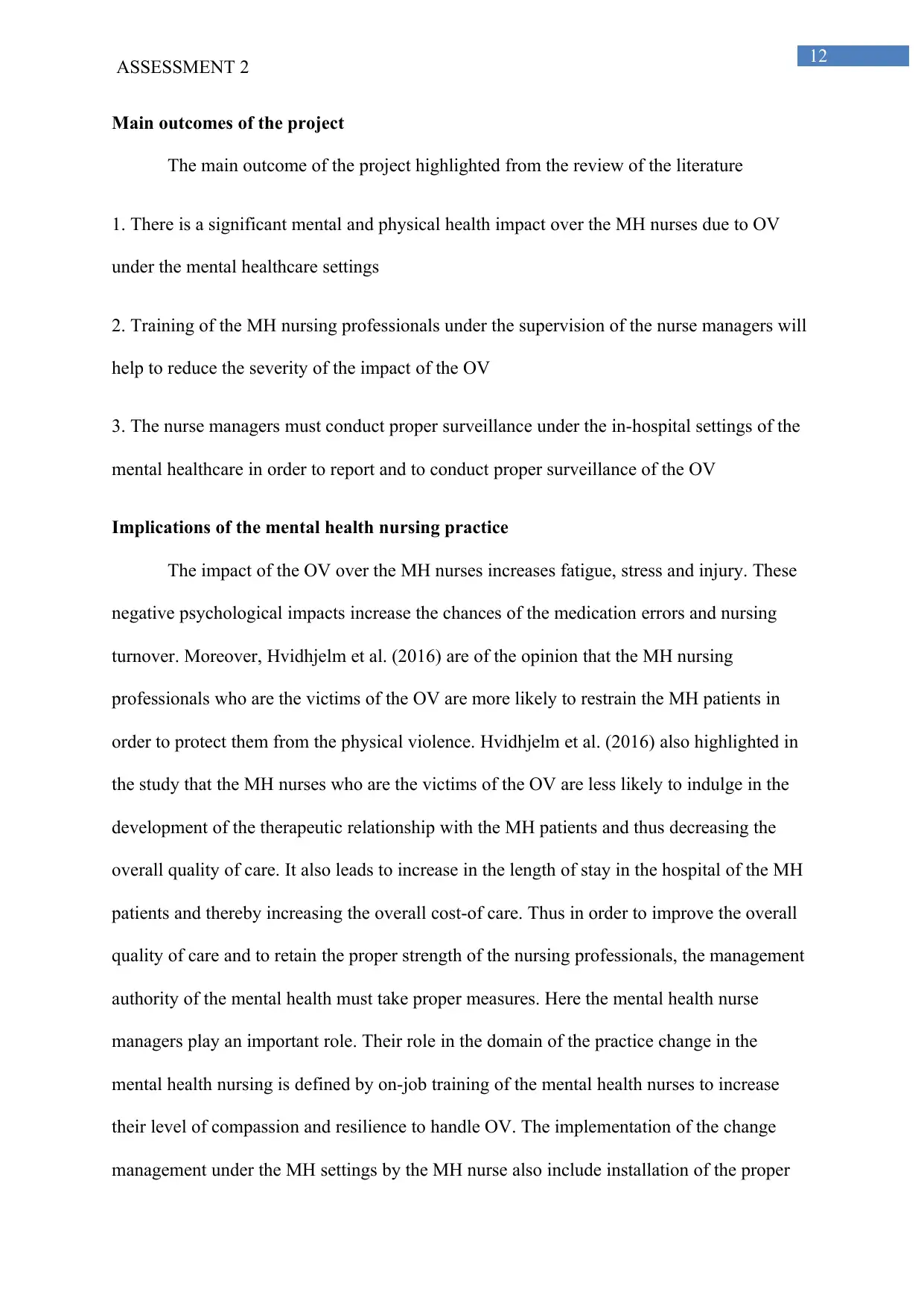
12
ASSESSMENT 2
Main outcomes of the project
The main outcome of the project highlighted from the review of the literature
1. There is a significant mental and physical health impact over the MH nurses due to OV
under the mental healthcare settings
2. Training of the MH nursing professionals under the supervision of the nurse managers will
help to reduce the severity of the impact of the OV
3. The nurse managers must conduct proper surveillance under the in-hospital settings of the
mental healthcare in order to report and to conduct proper surveillance of the OV
Implications of the mental health nursing practice
The impact of the OV over the MH nurses increases fatigue, stress and injury. These
negative psychological impacts increase the chances of the medication errors and nursing
turnover. Moreover, Hvidhjelm et al. (2016) are of the opinion that the MH nursing
professionals who are the victims of the OV are more likely to restrain the MH patients in
order to protect them from the physical violence. Hvidhjelm et al. (2016) also highlighted in
the study that the MH nurses who are the victims of the OV are less likely to indulge in the
development of the therapeutic relationship with the MH patients and thus decreasing the
overall quality of care. It also leads to increase in the length of stay in the hospital of the MH
patients and thereby increasing the overall cost-of care. Thus in order to improve the overall
quality of care and to retain the proper strength of the nursing professionals, the management
authority of the mental health must take proper measures. Here the mental health nurse
managers play an important role. Their role in the domain of the practice change in the
mental health nursing is defined by on-job training of the mental health nurses to increase
their level of compassion and resilience to handle OV. The implementation of the change
management under the MH settings by the MH nurse also include installation of the proper
ASSESSMENT 2
Main outcomes of the project
The main outcome of the project highlighted from the review of the literature
1. There is a significant mental and physical health impact over the MH nurses due to OV
under the mental healthcare settings
2. Training of the MH nursing professionals under the supervision of the nurse managers will
help to reduce the severity of the impact of the OV
3. The nurse managers must conduct proper surveillance under the in-hospital settings of the
mental healthcare in order to report and to conduct proper surveillance of the OV
Implications of the mental health nursing practice
The impact of the OV over the MH nurses increases fatigue, stress and injury. These
negative psychological impacts increase the chances of the medication errors and nursing
turnover. Moreover, Hvidhjelm et al. (2016) are of the opinion that the MH nursing
professionals who are the victims of the OV are more likely to restrain the MH patients in
order to protect them from the physical violence. Hvidhjelm et al. (2016) also highlighted in
the study that the MH nurses who are the victims of the OV are less likely to indulge in the
development of the therapeutic relationship with the MH patients and thus decreasing the
overall quality of care. It also leads to increase in the length of stay in the hospital of the MH
patients and thereby increasing the overall cost-of care. Thus in order to improve the overall
quality of care and to retain the proper strength of the nursing professionals, the management
authority of the mental health must take proper measures. Here the mental health nurse
managers play an important role. Their role in the domain of the practice change in the
mental health nursing is defined by on-job training of the mental health nurses to increase
their level of compassion and resilience to handle OV. The implementation of the change
management under the MH settings by the MH nurse also include installation of the proper
Paraphrase This Document
Need a fresh take? Get an instant paraphrase of this document with our AI Paraphraser
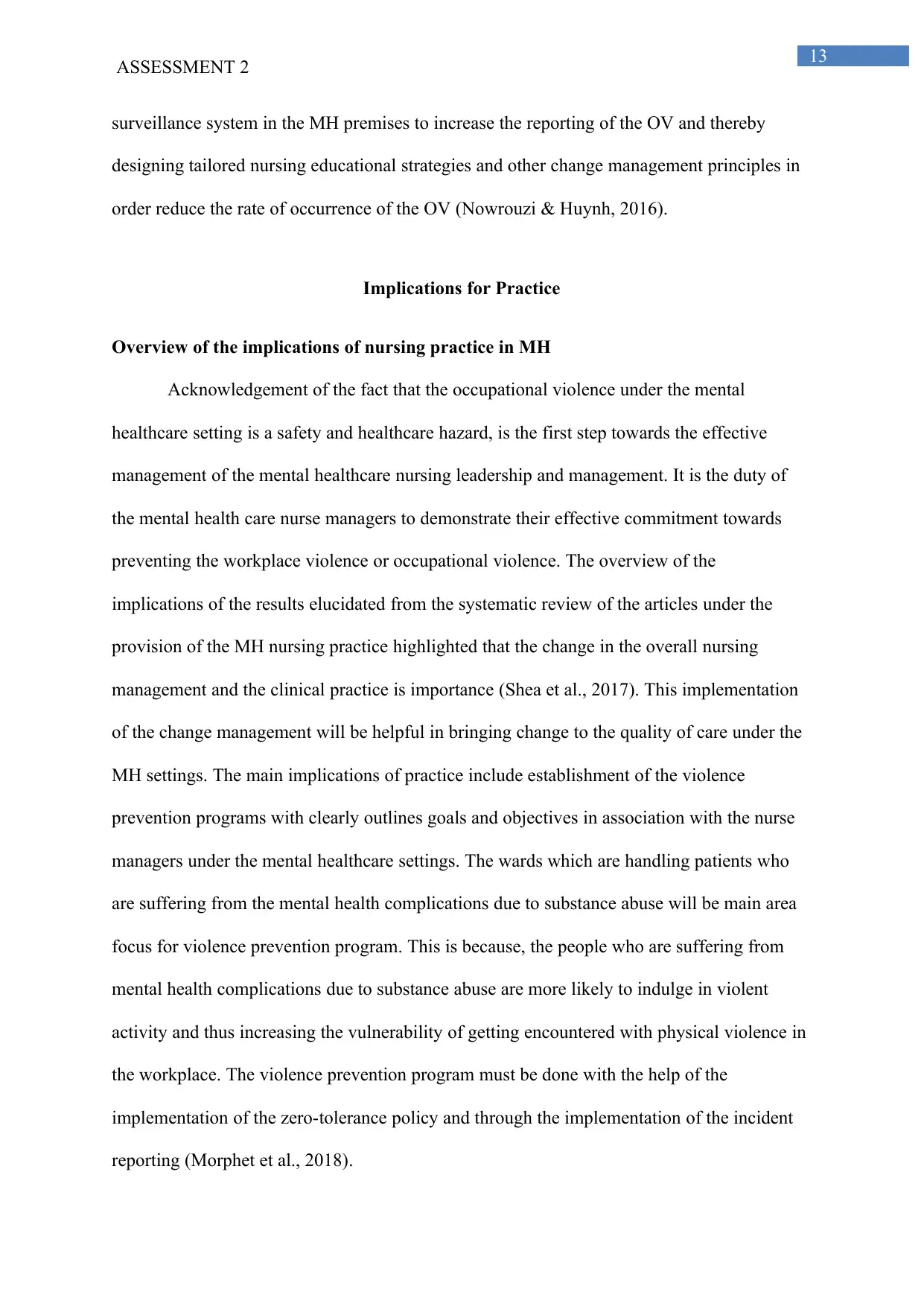
13
ASSESSMENT 2
surveillance system in the MH premises to increase the reporting of the OV and thereby
designing tailored nursing educational strategies and other change management principles in
order reduce the rate of occurrence of the OV (Nowrouzi & Huynh, 2016).
Implications for Practice
Overview of the implications of nursing practice in MH
Acknowledgement of the fact that the occupational violence under the mental
healthcare setting is a safety and healthcare hazard, is the first step towards the effective
management of the mental healthcare nursing leadership and management. It is the duty of
the mental health care nurse managers to demonstrate their effective commitment towards
preventing the workplace violence or occupational violence. The overview of the
implications of the results elucidated from the systematic review of the articles under the
provision of the MH nursing practice highlighted that the change in the overall nursing
management and the clinical practice is importance (Shea et al., 2017). This implementation
of the change management will be helpful in bringing change to the quality of care under the
MH settings. The main implications of practice include establishment of the violence
prevention programs with clearly outlines goals and objectives in association with the nurse
managers under the mental healthcare settings. The wards which are handling patients who
are suffering from the mental health complications due to substance abuse will be main area
focus for violence prevention program. This is because, the people who are suffering from
mental health complications due to substance abuse are more likely to indulge in violent
activity and thus increasing the vulnerability of getting encountered with physical violence in
the workplace. The violence prevention program must be done with the help of the
implementation of the zero-tolerance policy and through the implementation of the incident
reporting (Morphet et al., 2018).
ASSESSMENT 2
surveillance system in the MH premises to increase the reporting of the OV and thereby
designing tailored nursing educational strategies and other change management principles in
order reduce the rate of occurrence of the OV (Nowrouzi & Huynh, 2016).
Implications for Practice
Overview of the implications of nursing practice in MH
Acknowledgement of the fact that the occupational violence under the mental
healthcare setting is a safety and healthcare hazard, is the first step towards the effective
management of the mental healthcare nursing leadership and management. It is the duty of
the mental health care nurse managers to demonstrate their effective commitment towards
preventing the workplace violence or occupational violence. The overview of the
implications of the results elucidated from the systematic review of the articles under the
provision of the MH nursing practice highlighted that the change in the overall nursing
management and the clinical practice is importance (Shea et al., 2017). This implementation
of the change management will be helpful in bringing change to the quality of care under the
MH settings. The main implications of practice include establishment of the violence
prevention programs with clearly outlines goals and objectives in association with the nurse
managers under the mental healthcare settings. The wards which are handling patients who
are suffering from the mental health complications due to substance abuse will be main area
focus for violence prevention program. This is because, the people who are suffering from
mental health complications due to substance abuse are more likely to indulge in violent
activity and thus increasing the vulnerability of getting encountered with physical violence in
the workplace. The violence prevention program must be done with the help of the
implementation of the zero-tolerance policy and through the implementation of the incident
reporting (Morphet et al., 2018).
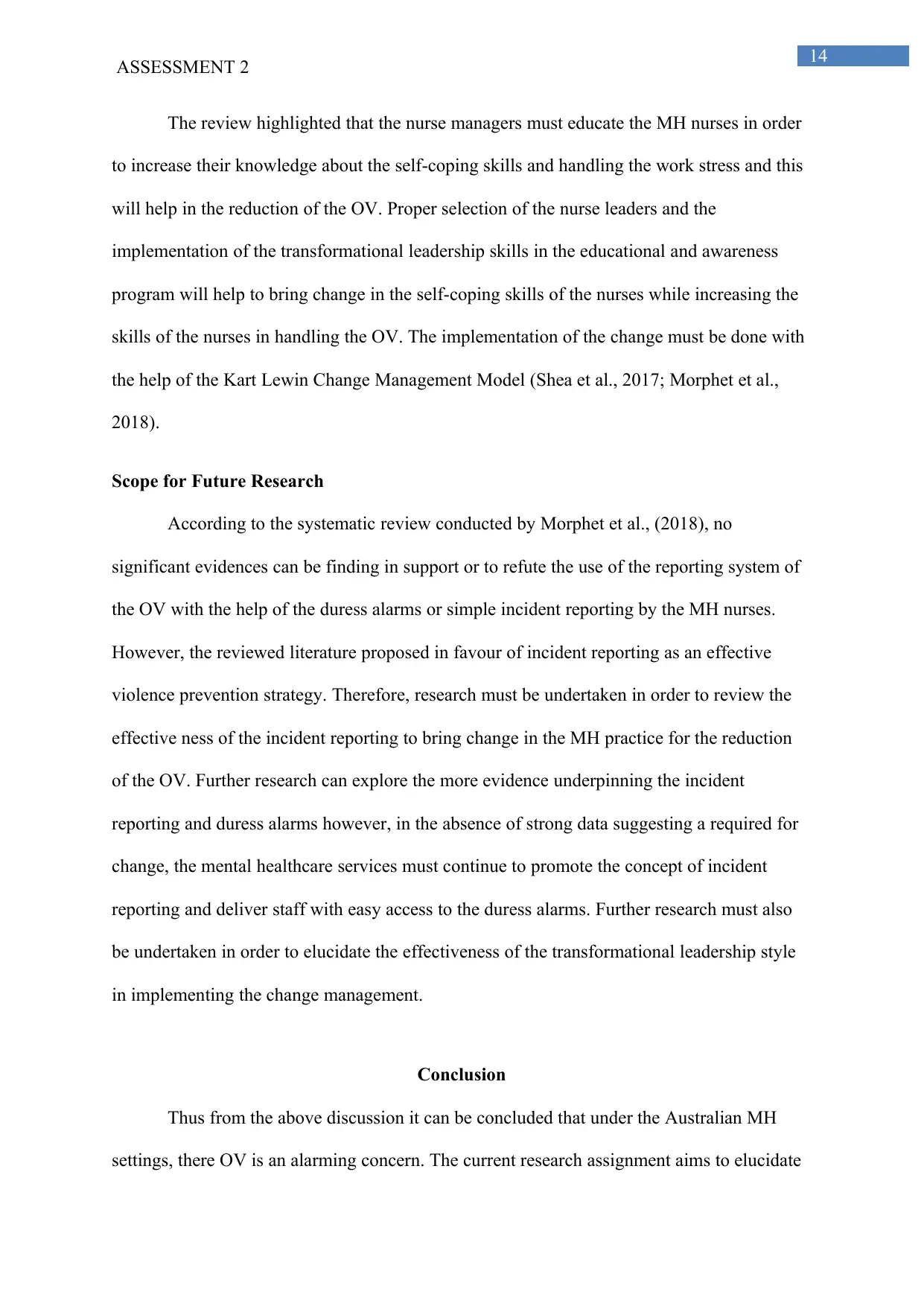
14
ASSESSMENT 2
The review highlighted that the nurse managers must educate the MH nurses in order
to increase their knowledge about the self-coping skills and handling the work stress and this
will help in the reduction of the OV. Proper selection of the nurse leaders and the
implementation of the transformational leadership skills in the educational and awareness
program will help to bring change in the self-coping skills of the nurses while increasing the
skills of the nurses in handling the OV. The implementation of the change must be done with
the help of the Kart Lewin Change Management Model (Shea et al., 2017; Morphet et al.,
2018).
Scope for Future Research
According to the systematic review conducted by Morphet et al., (2018), no
significant evidences can be finding in support or to refute the use of the reporting system of
the OV with the help of the duress alarms or simple incident reporting by the MH nurses.
However, the reviewed literature proposed in favour of incident reporting as an effective
violence prevention strategy. Therefore, research must be undertaken in order to review the
effective ness of the incident reporting to bring change in the MH practice for the reduction
of the OV. Further research can explore the more evidence underpinning the incident
reporting and duress alarms however, in the absence of strong data suggesting a required for
change, the mental healthcare services must continue to promote the concept of incident
reporting and deliver staff with easy access to the duress alarms. Further research must also
be undertaken in order to elucidate the effectiveness of the transformational leadership style
in implementing the change management.
Conclusion
Thus from the above discussion it can be concluded that under the Australian MH
settings, there OV is an alarming concern. The current research assignment aims to elucidate
ASSESSMENT 2
The review highlighted that the nurse managers must educate the MH nurses in order
to increase their knowledge about the self-coping skills and handling the work stress and this
will help in the reduction of the OV. Proper selection of the nurse leaders and the
implementation of the transformational leadership skills in the educational and awareness
program will help to bring change in the self-coping skills of the nurses while increasing the
skills of the nurses in handling the OV. The implementation of the change must be done with
the help of the Kart Lewin Change Management Model (Shea et al., 2017; Morphet et al.,
2018).
Scope for Future Research
According to the systematic review conducted by Morphet et al., (2018), no
significant evidences can be finding in support or to refute the use of the reporting system of
the OV with the help of the duress alarms or simple incident reporting by the MH nurses.
However, the reviewed literature proposed in favour of incident reporting as an effective
violence prevention strategy. Therefore, research must be undertaken in order to review the
effective ness of the incident reporting to bring change in the MH practice for the reduction
of the OV. Further research can explore the more evidence underpinning the incident
reporting and duress alarms however, in the absence of strong data suggesting a required for
change, the mental healthcare services must continue to promote the concept of incident
reporting and deliver staff with easy access to the duress alarms. Further research must also
be undertaken in order to elucidate the effectiveness of the transformational leadership style
in implementing the change management.
Conclusion
Thus from the above discussion it can be concluded that under the Australian MH
settings, there OV is an alarming concern. The current research assignment aims to elucidate
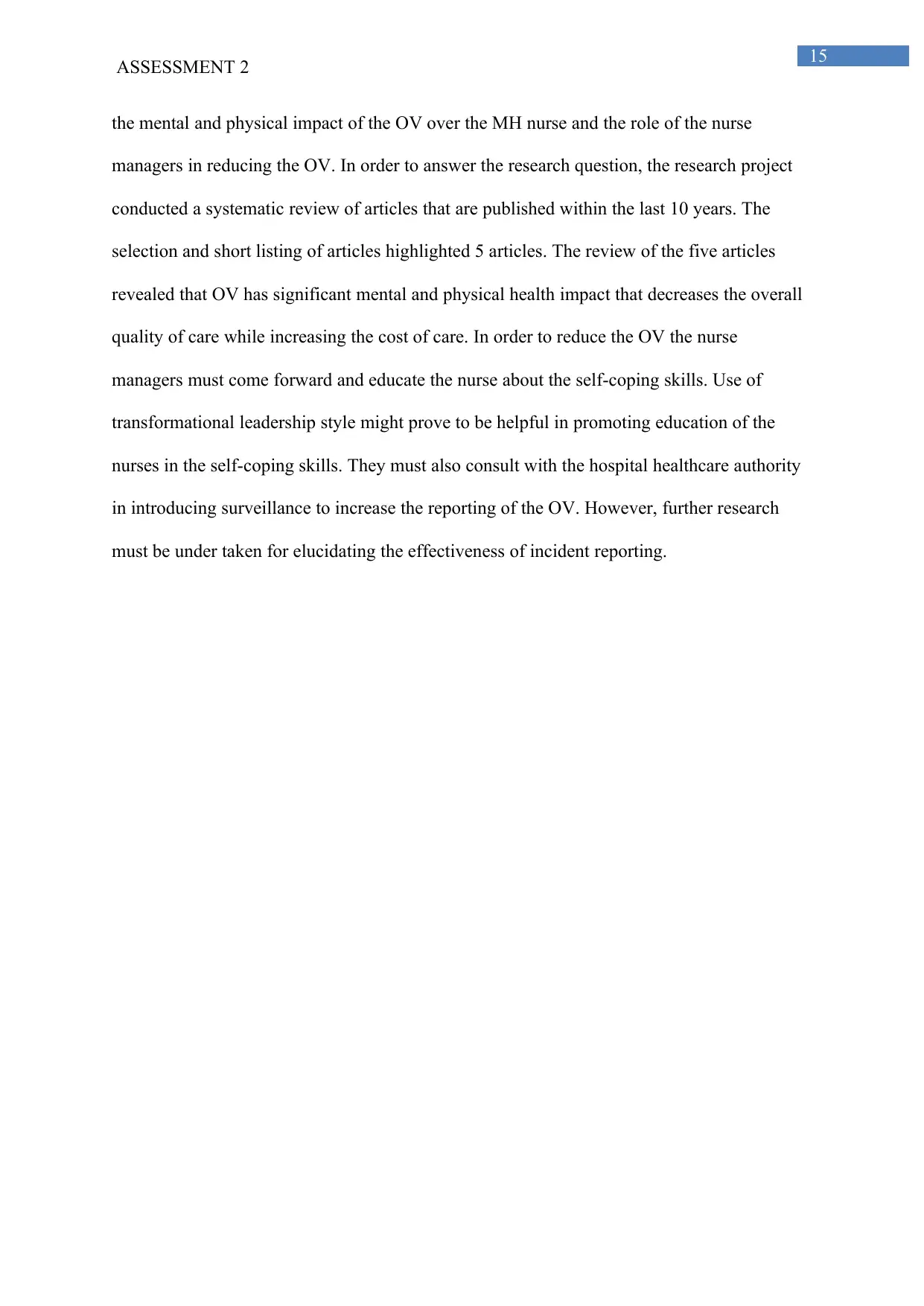
15
ASSESSMENT 2
the mental and physical impact of the OV over the MH nurse and the role of the nurse
managers in reducing the OV. In order to answer the research question, the research project
conducted a systematic review of articles that are published within the last 10 years. The
selection and short listing of articles highlighted 5 articles. The review of the five articles
revealed that OV has significant mental and physical health impact that decreases the overall
quality of care while increasing the cost of care. In order to reduce the OV the nurse
managers must come forward and educate the nurse about the self-coping skills. Use of
transformational leadership style might prove to be helpful in promoting education of the
nurses in the self-coping skills. They must also consult with the hospital healthcare authority
in introducing surveillance to increase the reporting of the OV. However, further research
must be under taken for elucidating the effectiveness of incident reporting.
ASSESSMENT 2
the mental and physical impact of the OV over the MH nurse and the role of the nurse
managers in reducing the OV. In order to answer the research question, the research project
conducted a systematic review of articles that are published within the last 10 years. The
selection and short listing of articles highlighted 5 articles. The review of the five articles
revealed that OV has significant mental and physical health impact that decreases the overall
quality of care while increasing the cost of care. In order to reduce the OV the nurse
managers must come forward and educate the nurse about the self-coping skills. Use of
transformational leadership style might prove to be helpful in promoting education of the
nurses in the self-coping skills. They must also consult with the hospital healthcare authority
in introducing surveillance to increase the reporting of the OV. However, further research
must be under taken for elucidating the effectiveness of incident reporting.
Secure Best Marks with AI Grader
Need help grading? Try our AI Grader for instant feedback on your assignments.
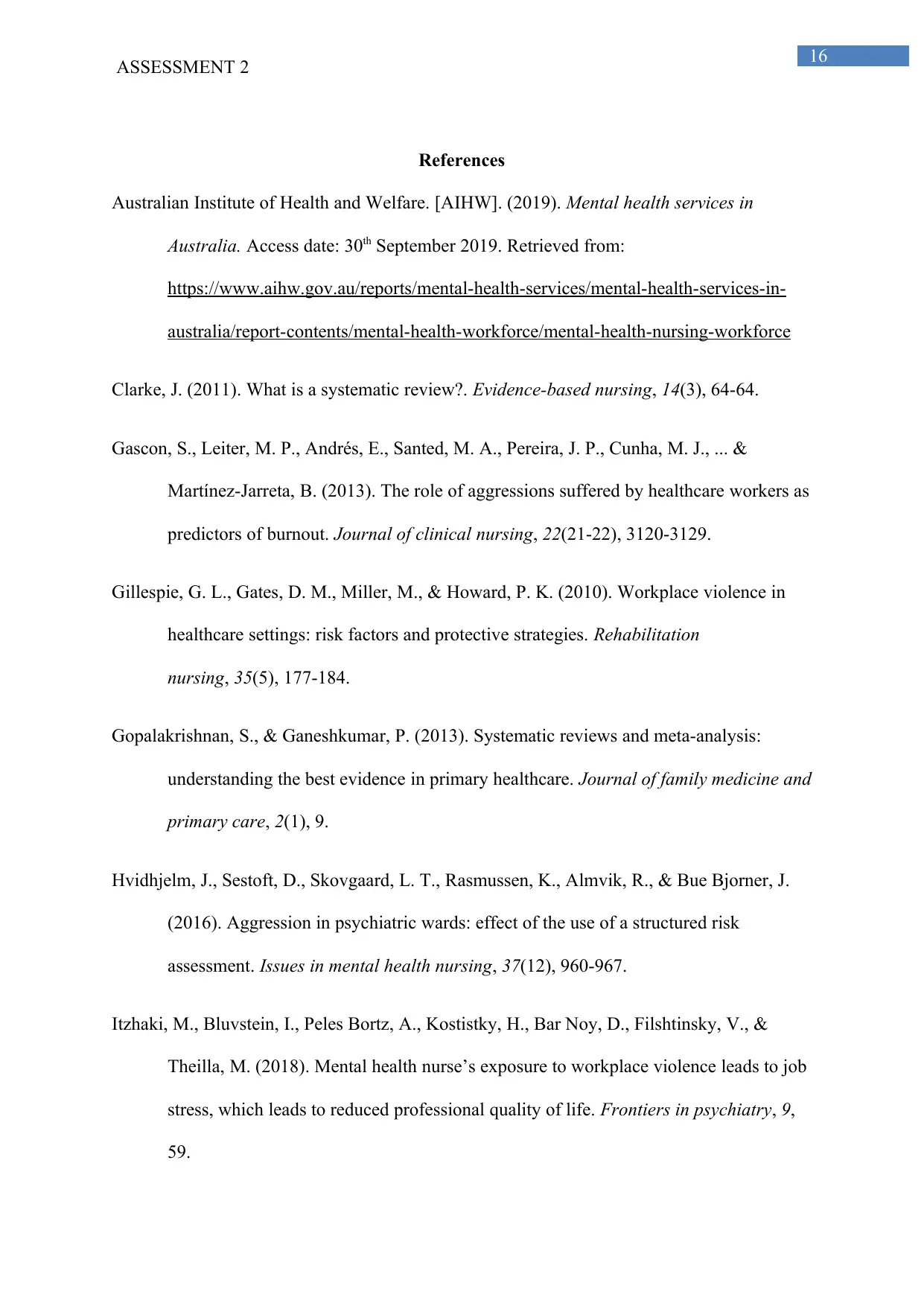
16
ASSESSMENT 2
References
Australian Institute of Health and Welfare. [AIHW]. (2019). Mental health services in
Australia. Access date: 30th September 2019. Retrieved from:
https://www.aihw.gov.au/reports/mental-health-services/mental-health-services-in-
australia/report-contents/mental-health-workforce/mental-health-nursing-workforce
Clarke, J. (2011). What is a systematic review?. Evidence-based nursing, 14(3), 64-64.
Gascon, S., Leiter, M. P., Andrés, E., Santed, M. A., Pereira, J. P., Cunha, M. J., ... &
Martínez‐Jarreta, B. (2013). The role of aggressions suffered by healthcare workers as
predictors of burnout. Journal of clinical nursing, 22(21-22), 3120-3129.
Gillespie, G. L., Gates, D. M., Miller, M., & Howard, P. K. (2010). Workplace violence in
healthcare settings: risk factors and protective strategies. Rehabilitation
nursing, 35(5), 177-184.
Gopalakrishnan, S., & Ganeshkumar, P. (2013). Systematic reviews and meta-analysis:
understanding the best evidence in primary healthcare. Journal of family medicine and
primary care, 2(1), 9.
Hvidhjelm, J., Sestoft, D., Skovgaard, L. T., Rasmussen, K., Almvik, R., & Bue Bjorner, J.
(2016). Aggression in psychiatric wards: effect of the use of a structured risk
assessment. Issues in mental health nursing, 37(12), 960-967.
Itzhaki, M., Bluvstein, I., Peles Bortz, A., Kostistky, H., Bar Noy, D., Filshtinsky, V., &
Theilla, M. (2018). Mental health nurse’s exposure to workplace violence leads to job
stress, which leads to reduced professional quality of life. Frontiers in psychiatry, 9,
59.
ASSESSMENT 2
References
Australian Institute of Health and Welfare. [AIHW]. (2019). Mental health services in
Australia. Access date: 30th September 2019. Retrieved from:
https://www.aihw.gov.au/reports/mental-health-services/mental-health-services-in-
australia/report-contents/mental-health-workforce/mental-health-nursing-workforce
Clarke, J. (2011). What is a systematic review?. Evidence-based nursing, 14(3), 64-64.
Gascon, S., Leiter, M. P., Andrés, E., Santed, M. A., Pereira, J. P., Cunha, M. J., ... &
Martínez‐Jarreta, B. (2013). The role of aggressions suffered by healthcare workers as
predictors of burnout. Journal of clinical nursing, 22(21-22), 3120-3129.
Gillespie, G. L., Gates, D. M., Miller, M., & Howard, P. K. (2010). Workplace violence in
healthcare settings: risk factors and protective strategies. Rehabilitation
nursing, 35(5), 177-184.
Gopalakrishnan, S., & Ganeshkumar, P. (2013). Systematic reviews and meta-analysis:
understanding the best evidence in primary healthcare. Journal of family medicine and
primary care, 2(1), 9.
Hvidhjelm, J., Sestoft, D., Skovgaard, L. T., Rasmussen, K., Almvik, R., & Bue Bjorner, J.
(2016). Aggression in psychiatric wards: effect of the use of a structured risk
assessment. Issues in mental health nursing, 37(12), 960-967.
Itzhaki, M., Bluvstein, I., Peles Bortz, A., Kostistky, H., Bar Noy, D., Filshtinsky, V., &
Theilla, M. (2018). Mental health nurse’s exposure to workplace violence leads to job
stress, which leads to reduced professional quality of life. Frontiers in psychiatry, 9,
59.
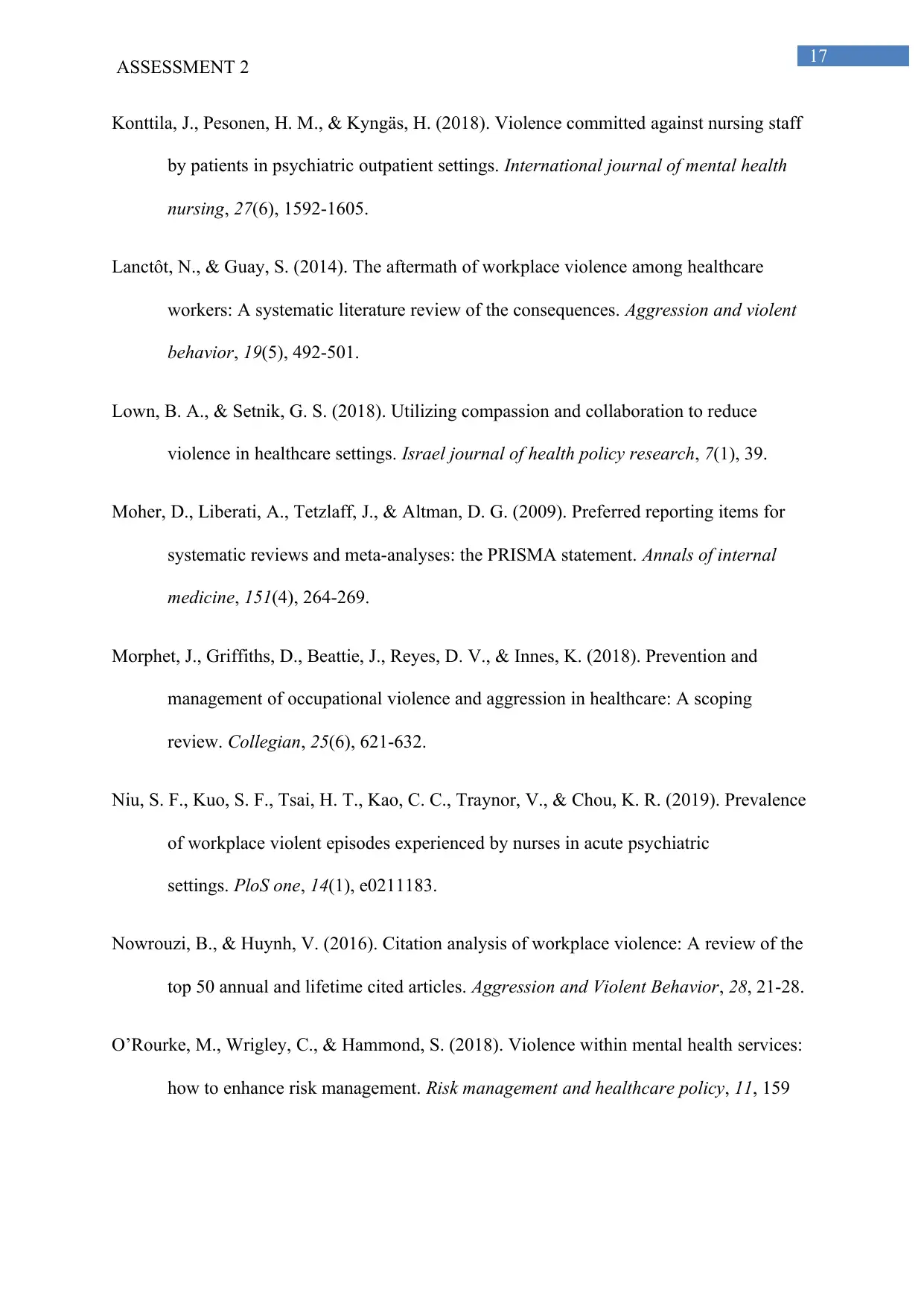
17
ASSESSMENT 2
Konttila, J., Pesonen, H. M., & Kyngäs, H. (2018). Violence committed against nursing staff
by patients in psychiatric outpatient settings. International journal of mental health
nursing, 27(6), 1592-1605.
Lanctôt, N., & Guay, S. (2014). The aftermath of workplace violence among healthcare
workers: A systematic literature review of the consequences. Aggression and violent
behavior, 19(5), 492-501.
Lown, B. A., & Setnik, G. S. (2018). Utilizing compassion and collaboration to reduce
violence in healthcare settings. Israel journal of health policy research, 7(1), 39.
Moher, D., Liberati, A., Tetzlaff, J., & Altman, D. G. (2009). Preferred reporting items for
systematic reviews and meta-analyses: the PRISMA statement. Annals of internal
medicine, 151(4), 264-269.
Morphet, J., Griffiths, D., Beattie, J., Reyes, D. V., & Innes, K. (2018). Prevention and
management of occupational violence and aggression in healthcare: A scoping
review. Collegian, 25(6), 621-632.
Niu, S. F., Kuo, S. F., Tsai, H. T., Kao, C. C., Traynor, V., & Chou, K. R. (2019). Prevalence
of workplace violent episodes experienced by nurses in acute psychiatric
settings. PloS one, 14(1), e0211183.
Nowrouzi, B., & Huynh, V. (2016). Citation analysis of workplace violence: A review of the
top 50 annual and lifetime cited articles. Aggression and Violent Behavior, 28, 21-28.
O’Rourke, M., Wrigley, C., & Hammond, S. (2018). Violence within mental health services:
how to enhance risk management. Risk management and healthcare policy, 11, 159
ASSESSMENT 2
Konttila, J., Pesonen, H. M., & Kyngäs, H. (2018). Violence committed against nursing staff
by patients in psychiatric outpatient settings. International journal of mental health
nursing, 27(6), 1592-1605.
Lanctôt, N., & Guay, S. (2014). The aftermath of workplace violence among healthcare
workers: A systematic literature review of the consequences. Aggression and violent
behavior, 19(5), 492-501.
Lown, B. A., & Setnik, G. S. (2018). Utilizing compassion and collaboration to reduce
violence in healthcare settings. Israel journal of health policy research, 7(1), 39.
Moher, D., Liberati, A., Tetzlaff, J., & Altman, D. G. (2009). Preferred reporting items for
systematic reviews and meta-analyses: the PRISMA statement. Annals of internal
medicine, 151(4), 264-269.
Morphet, J., Griffiths, D., Beattie, J., Reyes, D. V., & Innes, K. (2018). Prevention and
management of occupational violence and aggression in healthcare: A scoping
review. Collegian, 25(6), 621-632.
Niu, S. F., Kuo, S. F., Tsai, H. T., Kao, C. C., Traynor, V., & Chou, K. R. (2019). Prevalence
of workplace violent episodes experienced by nurses in acute psychiatric
settings. PloS one, 14(1), e0211183.
Nowrouzi, B., & Huynh, V. (2016). Citation analysis of workplace violence: A review of the
top 50 annual and lifetime cited articles. Aggression and Violent Behavior, 28, 21-28.
O’Rourke, M., Wrigley, C., & Hammond, S. (2018). Violence within mental health services:
how to enhance risk management. Risk management and healthcare policy, 11, 159
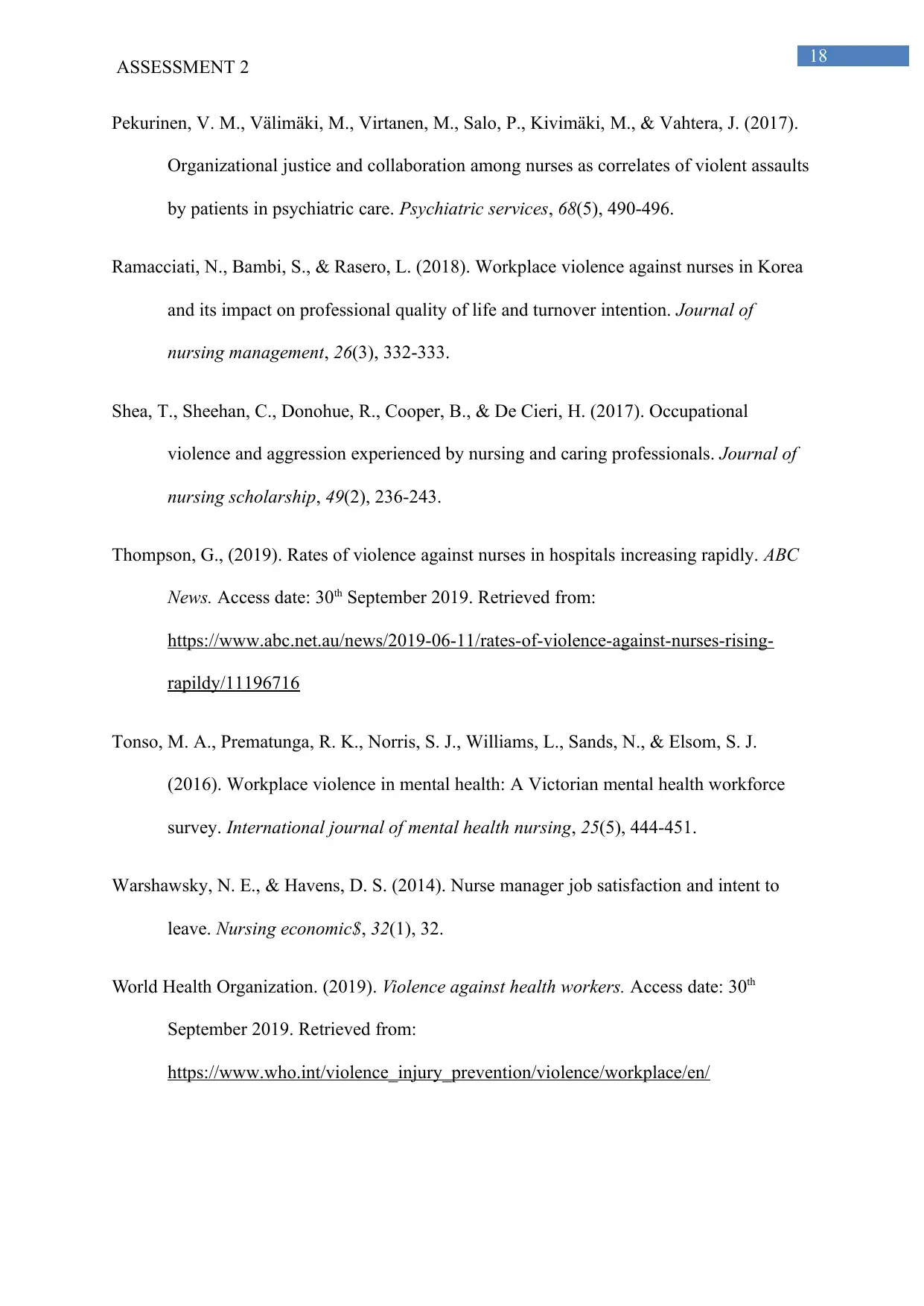
18
ASSESSMENT 2
Pekurinen, V. M., Välimäki, M., Virtanen, M., Salo, P., Kivimäki, M., & Vahtera, J. (2017).
Organizational justice and collaboration among nurses as correlates of violent assaults
by patients in psychiatric care. Psychiatric services, 68(5), 490-496.
Ramacciati, N., Bambi, S., & Rasero, L. (2018). Workplace violence against nurses in Korea
and its impact on professional quality of life and turnover intention. Journal of
nursing management, 26(3), 332-333.
Shea, T., Sheehan, C., Donohue, R., Cooper, B., & De Cieri, H. (2017). Occupational
violence and aggression experienced by nursing and caring professionals. Journal of
nursing scholarship, 49(2), 236-243.
Thompson, G., (2019). Rates of violence against nurses in hospitals increasing rapidly. ABC
News. Access date: 30th September 2019. Retrieved from:
https://www.abc.net.au/news/2019-06-11/rates-of-violence-against-nurses-rising-
rapildy/11196716
Tonso, M. A., Prematunga, R. K., Norris, S. J., Williams, L., Sands, N., & Elsom, S. J.
(2016). Workplace violence in mental health: A Victorian mental health workforce
survey. International journal of mental health nursing, 25(5), 444-451.
Warshawsky, N. E., & Havens, D. S. (2014). Nurse manager job satisfaction and intent to
leave. Nursing economic$, 32(1), 32.
World Health Organization. (2019). Violence against health workers. Access date: 30th
September 2019. Retrieved from:
https://www.who.int/violence_injury_prevention/violence/workplace/en/
ASSESSMENT 2
Pekurinen, V. M., Välimäki, M., Virtanen, M., Salo, P., Kivimäki, M., & Vahtera, J. (2017).
Organizational justice and collaboration among nurses as correlates of violent assaults
by patients in psychiatric care. Psychiatric services, 68(5), 490-496.
Ramacciati, N., Bambi, S., & Rasero, L. (2018). Workplace violence against nurses in Korea
and its impact on professional quality of life and turnover intention. Journal of
nursing management, 26(3), 332-333.
Shea, T., Sheehan, C., Donohue, R., Cooper, B., & De Cieri, H. (2017). Occupational
violence and aggression experienced by nursing and caring professionals. Journal of
nursing scholarship, 49(2), 236-243.
Thompson, G., (2019). Rates of violence against nurses in hospitals increasing rapidly. ABC
News. Access date: 30th September 2019. Retrieved from:
https://www.abc.net.au/news/2019-06-11/rates-of-violence-against-nurses-rising-
rapildy/11196716
Tonso, M. A., Prematunga, R. K., Norris, S. J., Williams, L., Sands, N., & Elsom, S. J.
(2016). Workplace violence in mental health: A Victorian mental health workforce
survey. International journal of mental health nursing, 25(5), 444-451.
Warshawsky, N. E., & Havens, D. S. (2014). Nurse manager job satisfaction and intent to
leave. Nursing economic$, 32(1), 32.
World Health Organization. (2019). Violence against health workers. Access date: 30th
September 2019. Retrieved from:
https://www.who.int/violence_injury_prevention/violence/workplace/en/
1 out of 19
Related Documents
Your All-in-One AI-Powered Toolkit for Academic Success.
+13062052269
info@desklib.com
Available 24*7 on WhatsApp / Email
![[object Object]](/_next/static/media/star-bottom.7253800d.svg)
Unlock your academic potential
© 2024 | Zucol Services PVT LTD | All rights reserved.





